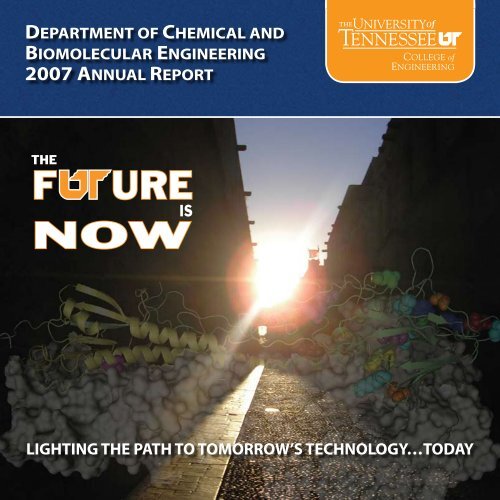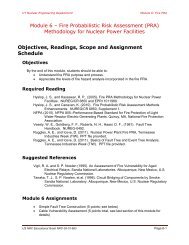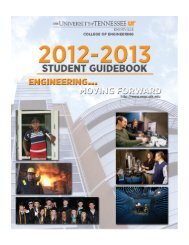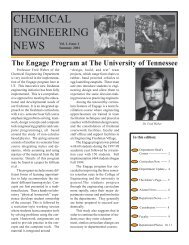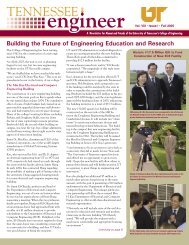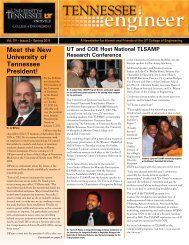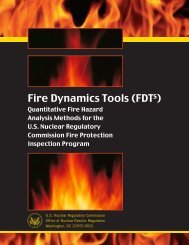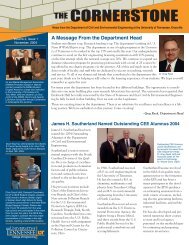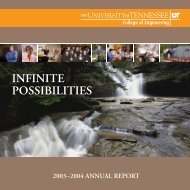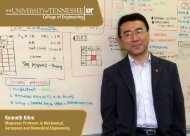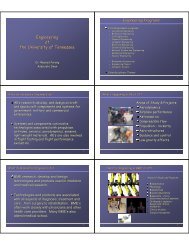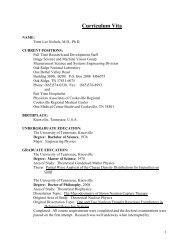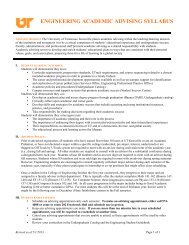CBE 2007 Annual Report - College of Engineering - The University ...
CBE 2007 Annual Report - College of Engineering - The University ...
CBE 2007 Annual Report - College of Engineering - The University ...
Create successful ePaper yourself
Turn your PDF publications into a flip-book with our unique Google optimized e-Paper software.
DEPARTMENT OF CHEMICAL AND<br />
BIOMOLECULAR ENGINEERING<br />
<strong>2007</strong> ANNUAL REPORT<br />
THE<br />
IS<br />
NOW<br />
LIGHTING THE PATH TO TOMORROW’S TECHNOLOGY…TODAY
CONTENTS<br />
Department Head’s Message 1<br />
<strong>The</strong> Power <strong>of</strong> Collaboration 2<br />
A Legacy <strong>of</strong> Excellence<br />
Dr. John Prados 4<br />
AIChE News 5<br />
Outstanding Faculty Member<br />
Dr. Brian Edwards 6<br />
ABET Accreditation 7<br />
Outstanding Graduate Student<br />
Jared Fern 8<br />
Outstanding Undergraduate<br />
Robyn Chaplin 9<br />
Outstanding Faculty Member<br />
Dr. Paul Frymier 10<br />
New Faculty Member<br />
Dr. Eric Boder 12<br />
New Faculty Member<br />
Dr. Stephen Paddison 13<br />
Outstanding Alumnus<br />
Dr. Michael Harris 14<br />
Renowned Lecturers 15<br />
Faculty Listing 16<br />
Superior Support 18<br />
Donor List 20<br />
Honors and Awards 21<br />
Publications, Contracts,<br />
Grants and Presentations 22<br />
Financial Information 25<br />
DEPARTMENT OF CHEMICAL AND BIOMOLECULAR ENGINEERING<br />
<strong>2007</strong> ANNUAL REPORT<br />
A project <strong>of</strong> the <strong>University</strong> <strong>of</strong> Tennessee <strong>College</strong> <strong>of</strong> <strong>Engineering</strong> Office <strong>of</strong> Communications.<br />
WRITER & EDITOR DESIGN & PRODUCTION WRITER<br />
Kim Cowart Craig Cook Amanda Womac<br />
Communications Manager Communications Coordinator Graduate Student Assistant<br />
CONTRIBUTING WRITER<br />
Jay Mayfield<br />
UT Office <strong>of</strong> Public Relations<br />
CONTRIBUTING PHOTOGRAPHERS<br />
Rip Noel Nick Myers David Luttrell<br />
Rip Noel Studios UT Photo Services<br />
<strong>The</strong> information in this report reflects the time period from July 1, 2006 through June 30, <strong>2007</strong>.<br />
<strong>The</strong> <strong>University</strong> <strong>of</strong> Tennessee does not discriminate on the basis <strong>of</strong> race, sex, color, religion, national origin, age,<br />
disability or veteran status in provision <strong>of</strong> educational programs and services or employment opportunities and<br />
benefits. This policy extends to both employment by and admission to the <strong>University</strong>.<br />
<strong>The</strong> <strong>University</strong> does not discriminate on the basis <strong>of</strong> race, sex, or disability in its education programs and activities<br />
pursuant to the requirements <strong>of</strong> Title VI <strong>of</strong> the Civil Rights Act <strong>of</strong> 1964, Title IX <strong>of</strong> the Education Amendments <strong>of</strong><br />
1972, Section 504 <strong>of</strong> the Rehabilitation Act <strong>of</strong> 1973, and the Americans with Disabilities Act (ADA) <strong>of</strong> 1990.<br />
Inquiries and charges <strong>of</strong> violation concerning Title VI, Title IX, Section 504, ADA or the Age Discrimination in Employment<br />
Act (ADEA) or any <strong>of</strong> the other above referenced policies should be directed to the Office <strong>of</strong> Equity and Diversity<br />
(OED), 1840 Melrose Avenue, Knoxville, TN 37996-3560, telephone (865) 974-2498 (V/TTY available) or 974-2440.<br />
Requests for accommodation <strong>of</strong> a disability should be directed to the ADA Coordinator at the UTK Office <strong>of</strong> Human<br />
Resources, 600 Henley Street, Knoxville, TN 37996-4125.<br />
<strong>The</strong> <strong>University</strong> <strong>of</strong> Tennessee, Knoxville, in its efforts to ensure a welcoming environment for all persons, does not<br />
discriminate on the basis <strong>of</strong> sexual orientation in its campus-based programs, services, and activities. Inquiries and<br />
complaints should be directed to the Office <strong>of</strong> Equity and Diversity.<br />
Publication Authorization Number: E01-1320-010-08 DOP: 10/26/07<br />
©<strong>2007</strong> <strong>The</strong> <strong>University</strong> <strong>of</strong> Tennessee Office <strong>of</strong> <strong>Engineering</strong> Communications. All rights reserved.<br />
DEPARTMENT HEAD’S MESSAGE<br />
R<br />
ecent advances in life sciences and nanotechnology, as well as the looming energy crisis, have<br />
brought chemical engineering education to the threshold <strong>of</strong> significant changes. <strong>The</strong> Department<br />
<strong>of</strong> Chemical and Biomolecular <strong>Engineering</strong> (<strong>CBE</strong>) at the <strong>University</strong> <strong>of</strong> Tennessee, Knoxville (UTK)<br />
is transitioning to embrace and fully utilize these changes to meet global challenges in health care, the<br />
environment, renewable energy sources, national security and economic prosperity.<br />
New demands on chemical engineering graduates, such as cross-permeation <strong>of</strong> ideas from evolving fields <strong>of</strong><br />
biology, medicine and sustainability have provided the motivation for revision <strong>of</strong> our education research foci<br />
with an emphasis on biological systems and micro- and nano-structured materials, as well as sustainable energy.<br />
In early <strong>2007</strong> we adopted a new name, Department <strong>of</strong> Chemical and Biomolecular <strong>Engineering</strong>, to reflect<br />
significant changes in our program.<br />
Full implementation <strong>of</strong> this new paradigm requires willingness to cross boundaries in our research and teaching<br />
programs. We are instituting innovative partnerships with other disciplines at UT, such as medical, life and<br />
physical sciences, as well as with the <strong>College</strong> <strong>of</strong> Business Administration.<br />
Close collaboration with Oak Ridge National Laboratory (ORNL) through the Joint Institutes <strong>of</strong> Advanced Materials<br />
(JIAM), Biological Sciences (JIBS) and Computational Sciences (JICS) provide<br />
our students opportunities to use state-<strong>of</strong>-the-art supercomputers and<br />
obtain access to the Spallation Neutron Source (SNS), a one-<strong>of</strong>-a-kind facility<br />
providing the most intense pulsed neutron beams in the world.<br />
In addition to joint ventures with ORNL, we have also established strong<br />
collaborations with two centers <strong>of</strong> excellence on the UTK campus, namely<br />
the Institute for Sustainable and Secure Environment (ISSE) and the Sustainable<br />
Energy Education and Research Center (SEERC), to provide our students<br />
world-class research and educational opportunities in the sustainable energy<br />
and technology arena.<br />
I hope this brief overview has detailed the critical issues <strong>of</strong> this exciting transitional<br />
time in our department. Please <strong>of</strong>fer us your support as we begin this<br />
crucial and timely transition, in which we strive to educate students for leadership<br />
roles in vital future technologies.<br />
Bamin Khomami<br />
Armour T. Granger and Alvin & Sally Beaman Distinguished Pr<strong>of</strong>essor and<br />
Head <strong>of</strong> Chemical and Biomolecular <strong>Engineering</strong><br />
Dr. Bamin Khomami<br />
<strong>2007</strong> ANNUAL REPORT 1
THE POWER OF COLLABORATION<br />
S<br />
ustainable energy seems to be the new buzzword in both research and education on college campuses<br />
across the United States. At the <strong>University</strong> <strong>of</strong> Tennessee, Knoxville (UT), significant changes<br />
in the Department <strong>of</strong> Chemical and Biomolecular <strong>Engineering</strong> (<strong>CBE</strong>) have helped shape what the<br />
future <strong>of</strong> energy will look like. Within <strong>CBE</strong>, researchers work on three prongs <strong>of</strong> sustainable energy: photovoltaics,<br />
bio-fuels and fuel cells. Current research projects include inorganic and hybrid polymeric-biological<br />
photovoltaic materials; polyelectrolyte membrane hydrogen fuel cells; and hydrogen generation via<br />
water splitting.<br />
Solar energy has long been touted as an alternative energy, but with high costs and low efficiency. Siliconbased<br />
solar cells, first introduced in 1954 by Bell Labs, use an exorbitant amount <strong>of</strong> labor and energy when<br />
produced, which end up costing the consumer a fortune. Dr. Bamin Khomami, Armour T. Granger and Alvin<br />
& Sally Beaman distinguished pr<strong>of</strong>essor and head <strong>of</strong> <strong>CBE</strong>, works to improve photovoltaic efficiencies and<br />
thinks that within 10 years, worldwide consumption could jump by an order magnitude.<br />
“Compared to fossil fuels technology, photovoltaic technology is in its infancy, but advancing at a rapid<br />
pace,” said Khomami, who works on development <strong>of</strong> photovoltaic films created from specifically tailored<br />
semiconducting nanoparticles and coatings. “Photons contain energy that corresponds to different wavelengths<br />
<strong>of</strong> light,” said Khomami. “Only photons <strong>of</strong> the right energy can excite electrons in a given system,<br />
which then flow to create an electrical current.” Nanoparticles can be tuned, making them photoactive in<br />
different ranges <strong>of</strong> light and attractive prospects for researchers. “We are currently collaborating<br />
with Pr<strong>of</strong>essor Biswas from Washington <strong>University</strong> to develop a simulation<br />
guided single-step flame aerosol reactor for deposition <strong>of</strong> semi-conducting nanostructured<br />
films that allows rigorous control <strong>of</strong> film thickness, morphology, composition and<br />
crystallinity and in turn, photovoltaic efficiency,“ said Khomami.<br />
2 DEPARTMENT OF CHEMICAL AND BIOMOLECULAR ENGINEERING<br />
Currently, Khomami, along with colleagues in the Departments <strong>of</strong> Biochemistry and Cellular<br />
and Molecular Biology (Dr. Bruce) and Chemistry (Drs. Dadmun and Mays) at UT, is<br />
working to overcome a significant obstacle in the production <strong>of</strong> commercially relevant<br />
polymeric photovoltaics - the lack <strong>of</strong> a fundamental understanding <strong>of</strong> the relationship<br />
between the morphology and interfaces that exist in multi-component polymer systems<br />
to the resultant exciton dissociation, charge conduction and ultimate device efficiency.<br />
By incorporating biological complexes, Khomami hopes to develop novel polymer photovoltaics<br />
with controlled morphologies in order to address this shortcoming.<br />
Hydrogen is produced using green algae and cyanobacteria<br />
by separating the photosynthetic protein complexes and<br />
enzymes from the cells and suspending them in solution.<br />
“Incorporation <strong>of</strong> the biological complex at the biphasic interface<br />
will provide a dramatic improvement in the exciton<br />
dissociation process and thus provide a clear mechanism<br />
to improve device efficiency,” said Khomami. “<strong>The</strong> use <strong>of</strong><br />
diblock copolymers provides a robust method to control the<br />
morphology <strong>of</strong> the result photovoltaic material.” Researchers<br />
are faced with surmountable challenges in this process,<br />
including developing conducting polymers that microphase<br />
separately into traditional diblock morphologies and developing<br />
strategies to guide biological complexes to the biphasic<br />
interface to realize their potential <strong>of</strong> optimizing exciton<br />
dissociation. “<strong>The</strong> project plan is designed to address these<br />
hurdles while creating a material that optimizes the device<br />
efficiency by controlling the morphology and interfaces and<br />
simultaneously providing fundamental information to enable<br />
the reproducible and efficient production <strong>of</strong> the next<br />
generation <strong>of</strong> photovoltaic materials created from multicomponent<br />
conjugated polymer systems,” said Khomami.<br />
Dr. Brian Edwards, associate pr<strong>of</strong>essor and associate head <strong>of</strong><br />
<strong>CBE</strong>, and Drs. David Keffer and Stephen Paddison, associate<br />
pr<strong>of</strong>essors in <strong>CBE</strong>, also play a significant role in the sustainable<br />
energy arena through their work on proton transport in<br />
proton exchange membrane (PEM) fuel cells.<br />
“<strong>The</strong> idea is that it doesn’t matter if you’re generating energy<br />
for a power plant, home or car, all these processes create CO2<br />
and contribute to the main cause <strong>of</strong> global warming,” said<br />
Keffer. “We need to find alternative ways <strong>of</strong> generating power<br />
and relevant to this theme <strong>of</strong> sustainable energy research in<br />
the university is the work we’re doing with fuel cells.”<br />
In a fuel cell, hydrogen enters and is split into protons and<br />
electrons by a platinum catalyst. Electrons are carried <strong>of</strong>f to<br />
do electrical work, and the protons have to complete the<br />
circuit by being transported through a membrane separat-<br />
ing the electrodes. But for over 40 years, researchers have<br />
been stumped as to how the protons move through the<br />
electrode-electrolyte interface. Keffer, Edwards and Paddison<br />
are performing multiscale simulations to elucidate the<br />
mechanism <strong>of</strong> proton transport and nanostructure formation<br />
in PEM fuel cells.<br />
“We’re going to have to start thinking differently about how<br />
we make energy because we can’t make it like we are now,”<br />
said Dr. Paul Frymier, associate pr<strong>of</strong>essor in <strong>CBE</strong> whose forward-thinking<br />
idea <strong>of</strong> energy production is to use plants for<br />
energy.<br />
For billions <strong>of</strong> years, plants have transformed sunlight into<br />
energy through photosynthesis. Frymier and Dr. Barry Bruce,<br />
pr<strong>of</strong>essor <strong>of</strong> biochemistry and cellular and molecular biology<br />
and adjunct pr<strong>of</strong>essor in <strong>CBE</strong> at UT, believe this natural<br />
process can be used to create energy efficiently. “I’ve always<br />
been curious about a way to produce energy sustainably,”<br />
said Frymier whose research focus is on in vitro (cell-free)<br />
systems for producing hydrogen because lots <strong>of</strong> energy is invested<br />
in sustaining enough live algae to produce hydrogen.<br />
Frymier also concentrates on engineering and optimization<br />
<strong>of</strong> photosynthetic routes to biohydrogen.<br />
Whether processing spinach, PV films or proton exchange<br />
membranes, <strong>CBE</strong> researchers are contributing to the future <strong>of</strong><br />
sustainable research and development in the energy sector.<br />
“<strong>The</strong>re’s more to sustainability than energy,” said Bruce. “It’s<br />
never been part <strong>of</strong> the equation, but we have to change the<br />
energy dimension <strong>of</strong> the production process. We’re trying to<br />
create a paradigm shift in how engineers are trained. <strong>The</strong>y<br />
have not put sustainability in their equations, and I believe<br />
the new paradigm <strong>of</strong> engineering will have to address more<br />
complex parameters than the typical engineer usually does.”<br />
<strong>2007</strong> ANNUAL REPORT 3
A LEGACY OF EXCELLENCE<br />
F ifty<br />
years after completing his doctorate in chemical engineering at the institution he has since<br />
called home, the <strong>University</strong> <strong>of</strong> Tennessee’s John Prados is being recognized for a lifetime <strong>of</strong><br />
achievement in his field.<br />
Prados, pr<strong>of</strong>essor emeritus <strong>of</strong> chemical and biomolecular engineering and former UT vice president for<br />
academic affairs, has been named the recipient <strong>of</strong> the Lifetime Achievement in Chemical <strong>Engineering</strong><br />
Pedagogical Scholarship Award from the American Society <strong>of</strong> <strong>Engineering</strong> Education (ASEE). <strong>The</strong> award is<br />
regarded as the society’s highest honor for a chemical engineer. He received the award at the ASEE conference<br />
in Honolulu in June <strong>2007</strong>.<br />
<strong>The</strong> recognition reflects Prados’ extensive work to change the fundamentals <strong>of</strong> engineering education,<br />
making it more focused on how students apply their knowledge, rather than just the number <strong>of</strong> hours they<br />
spend in scientific and technical studies.<br />
Prados’ entire career has been spent at UT, except for periods <strong>of</strong> research at Oak Ridge National Laboratory<br />
(ORNL) and a three-year stint in the 1990s with the National Science Foundation (NSF), through which he<br />
worked with engineering education programs across the country.<br />
In 1969, Prados was named as associate dean <strong>of</strong> the <strong>College</strong> <strong>of</strong> <strong>Engineering</strong>, and<br />
in 1971 he moved to UT administration as dean <strong>of</strong> admissions and records. Two<br />
years later, he was designated as vice president for academic affairs.<br />
Prados also served as acting chancellor for UT-Knoxville and UT-Martin, and was<br />
the acting director for the UT Space Institute’s Energy Conversion Division. Prados<br />
also served as department head for the chemical engineering department<br />
from 1990 until 1993.<br />
Beginning in the 1970s, Prados worked with the Accreditation Board for <strong>Engineering</strong><br />
and Technology (ABET), the organization that accredits engineering programs<br />
around the country. This experience spurred his desire to bring change to<br />
how engineers are educated.<br />
“It became obvious to me that things needed to be fixed,” said Prados. “We were<br />
very strong in math and science, but we needed to help students put engineering<br />
in the context <strong>of</strong> economic, social and environmental realities.”<br />
Prados’ extensive background in education allowed him to view both the positives<br />
and negatives <strong>of</strong> traditional engineering education, and he determined<br />
Dr. John Prados<br />
that a broader focus was necessary as a critical component <strong>of</strong><br />
changing engineering curricula.<br />
“Math and science alone will not produce a device that is environmentally<br />
sound and aesthetically pleasing, for example,” he<br />
said. “We must help students recognize the implications <strong>of</strong> their<br />
work.”<br />
Prados was a member <strong>of</strong> the original Basic <strong>Engineering</strong> Renovation<br />
Team, a group commissioned by the late COE Dean Jerry<br />
Stoneking in 1996 to create improvements in the freshman engineering<br />
curriculum. <strong>The</strong> college’s <strong>Engineering</strong> Fundamentals<br />
Division (EFD) was established through the initiative and continues<br />
today as one <strong>of</strong> the most successful freshman engineering<br />
programs in the country. By helping focus engineering education<br />
on project-based learning, Prados’ influence can be felt<br />
in engineering classrooms both at UT and across the country.<br />
Another element <strong>of</strong> Prados’ legacy is the impact <strong>of</strong> his time as<br />
the editor <strong>of</strong> the Journal <strong>of</strong> <strong>Engineering</strong> Education. In that position,<br />
which he occupied from 1995 to 2001, Prados helped<br />
bring a greater level <strong>of</strong> scholarly rigor to the field <strong>of</strong> research in<br />
engineering education, which helped elevate the field’s stature<br />
in the larger engineering community.<br />
“John has provided many years <strong>of</strong> great service to us at UT and<br />
to our colleagues in engineering education around the world,”<br />
said Way Kuo, dean <strong>of</strong> UT’s <strong>College</strong> <strong>of</strong> <strong>Engineering</strong>. “He’s been<br />
a dedicated and tireless role model for countless faculty and<br />
students.”<br />
In spite <strong>of</strong> his <strong>of</strong>ficial retirement in 2001, Prados continues to be<br />
active, teaching courses at UT as well as consulting with other<br />
colleges and universities in the United States and abroad on<br />
methodology to improve their engineering education programs.<br />
AIChE Student Chapter Provides<br />
Many Valuable Opportunities<br />
Students in the Department <strong>of</strong> Chemical and<br />
Biomolecular <strong>Engineering</strong> (<strong>CBE</strong>) at the <strong>University</strong> <strong>of</strong> Tennessee<br />
(UT) have the opportunity to join the American<br />
Institute <strong>of</strong> Chemical Engineers (AIChE), the world’s leading<br />
organization for chemical engineering pr<strong>of</strong>essionals,<br />
with more than 40,000 members from 93 countries.<br />
Started in 1908, AIChE helped establish the discipline <strong>of</strong><br />
chemical engineering and set the foundation for a constantly<br />
evolving and vital pr<strong>of</strong>ession. More than 150 student<br />
chapters exist across the United States and provide<br />
resources for networking with chemical engineering majors<br />
and practicing engineers. Student chapters also provide<br />
information about mentoring opportunities, student<br />
conferences, scholarships and career opportunities.<br />
<strong>University</strong> <strong>of</strong> Tennessee, Knoxville AIChE 2008 <strong>of</strong>ficers are<br />
Jared Johnson, president; Bradley Harris, vice-president;<br />
Nickyla Alliowa, secretary; and Kristen Dobrodziej, treasurer.<br />
Dr. David Keffer, associate pr<strong>of</strong>essor, is the group’s<br />
faculty advisor.<br />
Nine students represented the <strong>CBE</strong> department at the <strong>2007</strong><br />
Southern Regional AIChE meeting hosted by the <strong>University</strong> <strong>of</strong><br />
South Carolina. From left to right: Ian Morris, Peter Haddix, David<br />
Keffer (chapter advisor), Matt Milazzo, Kyle Mack, Anne Wells,<br />
Brian Long, Brad Harris, Heath Johnson and Sarah Kyker (<strong>2007</strong><br />
chapter president).<br />
4 DEPARTMENT OF CHEMICAL AND BIOMOLECULAR ENGINEERING <strong>2007</strong> ANNUAL REPORT 5
Outstanding Faculty Member Dr. Brian<br />
Edwards (left) with researcher Bangwu Jiang<br />
THE BIG PICTURE<br />
W hen<br />
Brian Edwards was 9 years old, his<br />
home chemistry set was his favorite<br />
toy.<br />
“I had a lot <strong>of</strong> fun with it, but I cannot say the same<br />
for my parents” said Dr. Edwards, who is currently<br />
associate department head and associate pr<strong>of</strong>essor<br />
<strong>of</strong> chemical and biomolecular engineering at the<br />
<strong>University</strong> <strong>of</strong> Tennessee.<br />
Edwards started down the path <strong>of</strong> chemical engineering<br />
at the <strong>University</strong> <strong>of</strong> Illinois, where he received his B.S. in 1986. His interest in chemistry and chemical<br />
processes was what brought him to chemical engineering.<br />
“I wanted to be a chemist at first,” said Edwards, “but my advisor told me I would make at least 40 percent<br />
more salary per year as a chemical engineer. Although I did not then understand the distinction between<br />
the two fields, that was enough for me at the time and I switched majors. Only later did I learn that choosing<br />
chemical engineering was much more than planning a career path.”<br />
After receiving his Ph.D. in chemical engineering from the <strong>University</strong> <strong>of</strong> Delaware in Newark in 1991, Edwards<br />
decided his interests and abilities were geared toward academic pursuits.<br />
“I liked interacting with students and had ample opportunity to do so both at Illinois and Delaware as a<br />
teaching assistant,” said Edwards. “Furthermore, the academic freedom to pursue the engineering problems<br />
that interested me, as opposed to working on problems that someone else had mandated, also appealed<br />
to me.”<br />
Edwards’ primary research focus is at the interface <strong>of</strong> thermodynamics and fluid dynamics, especially as<br />
applied to the polymer processing operations used in the manufacture <strong>of</strong> semi-conductors, plastics, surgical<br />
devices and a myriad <strong>of</strong> other products used every day by billions <strong>of</strong> consumers worldwide. In his book,<br />
<strong>The</strong>rmodynamics <strong>of</strong> Flowing Systems with Internal Microstructure, co-authored with Dr. Antony N. Beris, he<br />
laid out a methodology for describing dynamical complex fluid processes from the ground up; this book<br />
has been cited over 350 times by other researchers.<br />
Sustainable energy is another area in which Edwards works, in collaboration with other pr<strong>of</strong>essors in the<br />
department; in particular, the conversion <strong>of</strong> hydrogen gas into electrical power.<br />
“I like to think about the big picture,” said Edwards. “Eventually,<br />
fossil fuels will dry up, maybe sooner than we expect. Alternative<br />
forms <strong>of</strong> energy are necessary, and hydrogen as a fuel has<br />
potential to impact energy use across the globe.”<br />
Fuel cells are part <strong>of</strong> this big picture for Edwards, who leads the<br />
Computational Materials Research Group with Dr. David Keffer,<br />
associate pr<strong>of</strong>essor <strong>of</strong> chemical and biomolecular engineering<br />
at UT. In a fuel cell, hydrogen enters and is split into protons<br />
and electrons by a platinum catalyst. For over 40 years, researchers<br />
have tried to understand how protons move through<br />
the electrode-electrolyte interface <strong>of</strong> fuel cells. With help from<br />
a Department <strong>of</strong> Energy grant, Edwards hopes to discover the<br />
answer through a computer model membrane he and Keffer<br />
created at the molecular level to look at the vehicular and structural<br />
diffusion that takes place with the cells.<br />
Edwards has also been recognized for his pr<strong>of</strong>essionalism in<br />
teaching and research. In 2003, he was awarded the <strong>College</strong><br />
<strong>of</strong> <strong>Engineering</strong> Outstanding Faculty Advisor Award and the<br />
Departmental Outstanding Teacher award. Four years later, Edwards<br />
was named a <strong>2007</strong> COE Research Fellow and received the<br />
Tom and Ruth Clark Award for Excellence in Chemical <strong>Engineering</strong><br />
Teaching.<br />
<strong>The</strong> primary reason Edwards joined the faculty at UT was that<br />
the <strong>College</strong> <strong>of</strong> <strong>Engineering</strong> and the Department <strong>of</strong> Chemical<br />
and Biomolecular <strong>Engineering</strong>, in particular, were poised for<br />
long-term and rapid growth.<br />
“I chose to teach at UT’s <strong>College</strong> <strong>of</strong> <strong>Engineering</strong> because I wanted<br />
to be part <strong>of</strong> building an imminent and sustainable national<br />
program <strong>of</strong> education and research in the chemical engineering<br />
pr<strong>of</strong>ession, rather than merely another cog in the machine<br />
<strong>of</strong> an already well-established institution.”<br />
<strong>CBE</strong> Department Maintains<br />
Continuous ABET Accreditation<br />
<strong>The</strong> Department <strong>of</strong> Chemical and Biomolecular <strong>Engineering</strong><br />
(<strong>CBE</strong>) was recently accredited for six more years<br />
through the Accreditation Board for <strong>Engineering</strong> and<br />
Technology (ABET), a non-governmental, peer-review<br />
body that certifies quality in engineering educational<br />
programs at the university level on a nationwide basis.<br />
Accreditation is not a ranking system, but instead ensures<br />
that rigorous standards <strong>of</strong> education, ethics, pr<strong>of</strong>essional<br />
development and lifelong learning are met. It also provides<br />
guidance to parents and<br />
students on which programs<br />
meet established quality standards.<br />
“In general, programs not certified<br />
by ABET are considered<br />
not to have a standard minimum<br />
quality,” said Dr. Masood<br />
Parang, associate dean for<br />
student affairs in the <strong>College</strong><br />
<strong>of</strong> <strong>Engineering</strong>. “Most employers are aware <strong>of</strong> the accreditation<br />
and would like to hire only graduates <strong>of</strong> the ABETaccredited<br />
engineering programs and schools.”<br />
ABET accreditation standards are set by pr<strong>of</strong>essionals<br />
through collaborative efforts <strong>of</strong> many technical and pr<strong>of</strong>essional<br />
societies. Although ABET accreditation is voluntary<br />
on the part <strong>of</strong> the institution, accreditation helps students<br />
and their parents choose quality college programs,<br />
and enables employers to recruit well-prepared graduates.<br />
Accreditation also gives colleges and universities a<br />
structured mechanism to assess, evaluate and improve<br />
the quality <strong>of</strong> their programs.<br />
6 DEPARTMENT OF CHEMICAL AND BIOMOLECULAR ENGINEERING <strong>2007</strong> ANNUAL REPORT 7
Outstanding Graduate Student Jared Fern<br />
REAL WORLD SOLUTIONS<br />
W<br />
hen Jared Fern started college at Middle Tennessee State<br />
<strong>University</strong>, he wanted to become a medical doctor. While<br />
studying biology and chemistry, however, Fern discovered a<br />
passion for chemistry and its applications to the real world.<br />
“<strong>The</strong> primary thing that interests me about chemical engineering is the<br />
connection <strong>of</strong> molecular interactions to real world problems,” said Fern,<br />
who received his B.S. in chemical engineering from UT in 2003. “I chose<br />
to study at UT because it has one <strong>of</strong> the premier programs in the state for<br />
chemical engineering.”<br />
Fern, originally from Columbia, Tenn., is currently working on his Ph.D. in<br />
chemical engineering. He is a member <strong>of</strong> the American Institute for Chemical Engineers (AIChE) and won the<br />
<strong>2007</strong> Jim and Sandra McKinney Outstanding Graduate Student Award.<br />
“My research interests are performing molecular simulations <strong>of</strong> vapor-liquid equilibrium and other complicated<br />
systems,” said Fern, who plans to obtain a postdoctoral position at a national laboratory. Fern has focused<br />
on the investigation <strong>of</strong> vapor-liquid equilibrium (VLE) by molecular simulation, specifically molecular<br />
dynamics, and has recently addressed the limitations <strong>of</strong> current molecular simulation methods for measuring<br />
VLE. Along with his departmental advisors, Dr. William Steele, research pr<strong>of</strong>essor, and Dr. David Keffer, associate<br />
pr<strong>of</strong>essor, Fern has invented a new self-consistent method to measure VLE using Voronoi Tessellations and has<br />
applied this method to industrially relevant compounds, such as ethanol and ethylene glycol.<br />
“<strong>The</strong> method utilizes Voronoi Tessellations to determine the volume <strong>of</strong> every molecule and atom in the simulation<br />
cell,” said Fern. “By coupling simple statistical parameters, such as the average molecular volume and variance<br />
<strong>of</strong> the molecular volume, one can determine the individual phases in a multiphase molecular simulation.”<br />
“Jared has not only become an expert in molecular dynamics simulation, but also has taken a leadership role<br />
in training incoming students and researchers in the UT Computational Materials Research Group,” said Keffer.<br />
“Jared has embraced each task <strong>of</strong>fered to him, ranging from setting up experimental equipment in the<br />
thermophysical properties lab, to running the molecular simulations that comprise the core <strong>of</strong> his research,<br />
to performing continuum-level models in support <strong>of</strong> other research projects outside the department. He is<br />
an extremely talented and reliable person, and it has been a pleasure to have been part <strong>of</strong> his growth as a researcher<br />
during his time as a graduate student.”<br />
MAKING AN IMPACT<br />
I<br />
t was chicken fat that first sparked Robyn Chaplin’s interest in chemical engineering when, as a high<br />
school junior in Nashville, Tenn., she read an article on using chicken fat to heat buildings at the <strong>University</strong><br />
<strong>of</strong> Georgia. “I thought it was an interesting solution to many problems, like foreign energy dependence<br />
and overflowing landfills,” said Chaplin. “I had always excelled at math and science, but wanted to study<br />
something where I would have an impact on human life. <strong>Engineering</strong> was the perfect fit.”<br />
Originally from Largo, Fla., Chaplin, a senior in chemical engineering, is interested in renewable energy and<br />
plans to put her technical skills to work in an industrial setting. “I like the versatility <strong>of</strong> chemical engineering.<br />
My degree will provide a strong foundation for working within many industries that affect daily life,” said Chaplin.<br />
“I have found I enjoy manufacturing and want to work at a plant that makes cellulosic ethanol, biodiesel, or<br />
something similar.”<br />
As a high school senior, Chaplin visited UT on Engineer’s Day and was fascinated with the concrete canoes,<br />
robots playing ping-pong and a hybrid car built by students. “Seeing math and science in action solidified my<br />
desire to be an engineer,” said Chaplin, who was impressed by freshman <strong>Engineering</strong> Fundamentals at UT, a<br />
program recognized nationally for its excellence.<br />
One <strong>of</strong> Chaplin’s most memorable experiences in the chemical engineering department was working on the<br />
“ChemE Car” project. “As a group <strong>of</strong> four, we attempted to fix a model car to be powered by a hydrogen fuel cell<br />
via a reaction <strong>of</strong> magnesium and hydrochloric acid. It seemed simple, but there were many challenges to overcome.<br />
<strong>The</strong> car drifted to one side and would not go a reproducible distance,<br />
even with the same chemical input,” said Chaplin. “<strong>The</strong> experience showed<br />
me that chemical engineering is not only theoretical, but a problem-solving<br />
discipline as well.”<br />
While at UT, Chaplin studied Spanish in Costa Rica during the fall <strong>of</strong> 2006.<br />
She also represented UT in the <strong>2007</strong> Nissan-World Wildlife Fund Environmental<br />
Leadership Program.<br />
“<strong>The</strong> program was highly beneficial in that it showcased environmental efforts<br />
from many fronts,” said Chaplin. “It solidified the fact that legal policy<br />
and conservation are not the only means <strong>of</strong> protecting the earth. Peoples’<br />
material needs can be met in a more sustainable manner and technical<br />
expertise is needed to achieve that goal, which encourages me to seriously<br />
pursue a career in bi<strong>of</strong>uel production.”<br />
Outstanding Undergraduate Student Robyn Chaplin<br />
8 DEPARTMENT OF CHEMICAL AND BIOMOLECULAR ENGINEERING <strong>2007</strong> ANNUAL REPORT 9
ENVIRONMENTALLY FRIENDLY ENERGY<br />
D<br />
r. Paul Frymier, associate pr<strong>of</strong>essor <strong>of</strong> chemical engineering at the <strong>University</strong> <strong>of</strong> Tennessee,<br />
thought he wanted to design airplanes for a living, so he initially obtained a degree in aerospace<br />
engineering. However, when it came to finding a job with a healthy impact on the environment,<br />
he was hard-pressed to find one.<br />
“Sustainable energy is something I’ve always been interested in,” said Frymier. “As a kid I used to do science<br />
experiments with photovoltaics and was always interested in the ‘how’ <strong>of</strong> energy.”<br />
After completing both bachelors and master’s degrees in aerospace engineering from North Carolina State<br />
<strong>University</strong> in 1985 and 1987, respectively, Frymier took a break from the books and headed into the Peace<br />
Corps, where he spent two years teaching high school-aged students and trying to implement educational<br />
and food production strategies to increase the quality <strong>of</strong> life <strong>of</strong> people in Gambia, West Africa.<br />
“I learned two things in the Peace Corps,” said Frymier. “One, the value <strong>of</strong> energy and sanitation in developing<br />
countries; and two, standard <strong>of</strong> living and quality <strong>of</strong> life are not always the same thing. If people are<br />
able to provide clean water and energy for food and medicine storage, it improves their quality <strong>of</strong> life.<br />
More televisions probably do not.”<br />
While in the Peace Corps, Frymier read books on clean water supply and sustainable energy technologies,<br />
and upon his return to the States, began looking for graduate programs that applied his fluid transport<br />
background to sustainable technologies.<br />
“Unfortunately, I was unable to find one,” said<br />
Frymier, who wanted more than advanced<br />
wind turbine designs. He eventually decided to<br />
enroll at the <strong>University</strong> <strong>of</strong> Virginia and apply his<br />
engineering background to rehabilitation engineering.<br />
However, said Frymier, “<strong>The</strong> fit wasn’t<br />
right. <strong>The</strong> problems were important and made<br />
a positive impact on people’s lives, but I did not<br />
find the work to be something I was personally<br />
excited about.”<br />
Meanwhile, a friend suggested he might find<br />
something interesting in chemical engineer-<br />
Outstanding Faculty Member Dr. Paul Frymier<br />
(left) with graduate student Mehrsa Raeiszadeh<br />
ing. “Initially I thought to myself, ‘But I haven’t really enjoyed<br />
chemistry’,” said Frymier. Luckily, the graduate program advisor<br />
in chemical engineering appreciated his background<br />
in transport. “A half hour later, I was majoring in chemical<br />
engineering on a full assistantship with a healthy stipend.”<br />
While in the first year <strong>of</strong> his Ph.D program, Frymier earned<br />
a fellowship through the Department <strong>of</strong> Energy to work on<br />
environmental remediation problems.<br />
Frymier graduated from the <strong>University</strong> <strong>of</strong> Virginia in 1995<br />
with a Ph.D. in chemical engineering and a desire to teach.<br />
“Throughout my education and career, faculty are the<br />
people I have most admired,” said Frymier. “I wanted to be a<br />
pr<strong>of</strong>essor rather than a captain <strong>of</strong> industry because I believe<br />
faculty are genuinely interested in their research and want to<br />
solve problems to have a significant impact on people’s lives.<br />
Pr<strong>of</strong>essors are accepted as bona fide experts doing important<br />
work and respected for it. That’s why I chose a teaching<br />
and research career.”<br />
And it seems Frymier found the right fit. Since he has been<br />
part <strong>of</strong> the faculty in the <strong>College</strong> <strong>of</strong> <strong>Engineering</strong>, Frymier has<br />
received the Leon and Nancy Cole Superior Teaching Award,<br />
<strong>2007</strong>; the Departmental Outstanding Teacher Award, 2002,<br />
2004 and 2006; and the Departmental Excellence in Teaching<br />
Award, 2004.<br />
Frymier’s early research at UT focused on two areas: mass<br />
and momentum transport and bacterial adhesion in environmental<br />
and biological systems and toxicity biosensors.<br />
He measured the characteristic properties <strong>of</strong> microbial<br />
interactions with solid surfaces to identify and quantify the<br />
mechanisms involved in the interactions. Simultaneously, he<br />
worked with graduate students to accurately and efficiently<br />
model microbial transport and remediation rates at contaminated<br />
waste sites. In his work on toxicity biosensors, he<br />
developed new hybrid sensor microorganisms and systems<br />
for monitoring aquatic toxicity.<br />
However, the time finally came for him to apply his work at<br />
the interface <strong>of</strong> biology and engineering in the Department<br />
<strong>of</strong> Chemical and Biomolecular <strong>Engineering</strong> to the sustainable<br />
production <strong>of</strong> fuel. He is pursuing this goal through<br />
his work with algae, cyanobacteria and the production <strong>of</strong><br />
hydrogen.<br />
“Since I was a kid tinkering with photovoltaic cells glued to<br />
model cars, I’ve always been interested in alternative energy<br />
sources for transportation,” said Frymier. “When looking for<br />
universities to work at, the thing that piqued my interest<br />
about UT was its close proximity to Oak Ridge National Laboratory<br />
and the on-campus Center for Environmental Biotechnology.<br />
<strong>The</strong> combination <strong>of</strong> campus resources and biological<br />
scientists and engineers coupled with the close relationship<br />
<strong>of</strong> UT and ORNL were major factors in my decision to settle<br />
in Knoxville.”<br />
Currently, Frymier’s research focus is on in vitro (cell-free)<br />
systems for producing hydrogen because lots <strong>of</strong> energy is invested<br />
in sustaining enough live algae to produce hydrogen.<br />
Frymier also concentrates on engineering and optimization<br />
<strong>of</strong> photosynthetic routes to biohydrogen.<br />
Frymier’s children, Fionna Martin, 10, and Gareth Frymier, 8,<br />
remind him <strong>of</strong> the necessity <strong>of</strong> his research.<br />
“<strong>The</strong>re’s a problem I want to be a part <strong>of</strong> solving,” said Frymier.<br />
“I’ve seen the difference in the developing world, and I<br />
want to help out. My kids will be inheriting this planet, and I<br />
want to be part <strong>of</strong> the solution for future generations.”<br />
10 DEPARTMENT OF CHEMICAL AND BIOMOLECULAR ENGINEERING <strong>2007</strong> ANNUAL REPORT 11
New Faculty Member Dr. Eric Boder<br />
STANDING OUT FROM THE CROWD<br />
D<br />
r. Eric Boder joined the Department <strong>of</strong> Chemical and Biomolecular <strong>Engineering</strong><br />
(<strong>CBE</strong>) August 1, <strong>2007</strong>. Boder received his B.S. in chemical engineering<br />
from Washington <strong>University</strong> in 1993 and continued to study chemical<br />
engineering at the graduate level at the <strong>University</strong> <strong>of</strong> Illinois, where he obtained both<br />
master’s and Ph.D. degrees in 1996 and 1999, respectively.<br />
Before coming to UT, Boder was assistant pr<strong>of</strong>essor in the Departments <strong>of</strong> Chemical<br />
and Biomolecular <strong>Engineering</strong> and Bioengineering at the <strong>University</strong> <strong>of</strong> Pennsylvania.<br />
He completed his postdoc work at the National Jewish Medical and Research Center in<br />
Denver, Colo., in the Department <strong>of</strong> Immunology.<br />
Boder’s research interest is molecular bioengineering. He is currently exploring two biomolecular systems that<br />
demonstrate switching in response to environmental conditions. In one case, Boder hopes to engineer controllable<br />
molecular switches that regulate adhesion <strong>of</strong> cells or particles to surfaces under flow. In the second<br />
case, Boder and his research team are developing tools for engineering controllable membrane fusion. “Both<br />
<strong>of</strong> these systems have a potential role in drug delivery and nonviral gene transfer,” said Boder. “In addition, my<br />
lab is working on novel ways to attach proteins to surfaces and to each other, which is an important issue in<br />
proteomics and bionanotechnology.”<br />
Throughout his academic career, Boder has stood out from the crowd and been recognized for his achievements.<br />
Boder received an NSF Graduate Research Fellowship from 1993-1996 and was a National Academy <strong>of</strong><br />
<strong>Engineering</strong> “Frontiers <strong>of</strong> <strong>Engineering</strong>” Invitee in 2002. He also received a prestigious NSF CAREER Award in<br />
2003 for his work titled “Biomolecular <strong>Engineering</strong> <strong>of</strong> Antigen Presentation: Development <strong>of</strong> an Interdisciplinary<br />
Research and Education Toolkit.” He is a member <strong>of</strong> the AIChE, Society for Biological <strong>Engineering</strong>, <strong>The</strong> Protein<br />
Society and the American Chemical Society. Boder has over 18 refereed publications and holds four U.S.<br />
patents.<br />
“UT is an institution on the rise in nearly every respect. A great vision <strong>of</strong> the future exists on this campus, in<br />
particular with respect to my own area <strong>of</strong> biomolecular science and engineering, and it is extremely exciting to<br />
join, and hopefully play a significant role, in the effort to achieve this vision,” said Boder. “<strong>The</strong> collegiality <strong>of</strong> colleagues<br />
across campus, the partnerships with Oak Ridge National Laboratory and the excellent support <strong>of</strong> the<br />
administration create a nearly unparalleled opportunity to make a real impact through research and education.<br />
Living in beautiful East Tennessee is an added bonus.”<br />
AN OPPORTUNITY TO CONTRIBUTE<br />
D<br />
r. Stephen J. Paddison joined the Department <strong>of</strong> Chemical and Biomolecular <strong>Engineering</strong><br />
(<strong>CBE</strong>) August 1, <strong>2007</strong>. Paddison, originally from Canada, comes to UT from the Department <strong>of</strong><br />
Chemistry at the <strong>University</strong> <strong>of</strong> Alabama, Huntsville (UAH), where he was an assistant pr<strong>of</strong>essor<br />
for three and half years.<br />
“I choose <strong>CBE</strong> at UT for the opportunity to join a department with faculty members active in computational<br />
materials science and engineering research,” said Paddison, who received his Ph.D. in physical and theoretical<br />
chemistry from the <strong>University</strong> <strong>of</strong> Calgary in 1996. “My research is both distinct and complimentary to theirs,<br />
and I saw the opportunity in <strong>CBE</strong> to contribute to common and new research thrusts with other members <strong>of</strong><br />
the department and the nearby Oak Ridge National Lab.”<br />
Paddison’s main focus <strong>of</strong> research is the polymer electrolyte membrane (PEM), which is used as the separator<br />
in low temperature proton exchange membrane (PEM) fuel cells. “My research continues to be in the general<br />
area <strong>of</strong> computational materials chemistry,” said Paddison. “Understanding the properties and chemistry <strong>of</strong><br />
materials at the molecular-level entails the application <strong>of</strong> a variety <strong>of</strong> methods including first principles based<br />
and statistical mechanical formulations.”<br />
Paddison was educated as a chemical physicist and has worked in industry and at the Los Alamos National<br />
Laboratory doing reservoir and materials engineering. “My interest in chemical engineering is not new,” said<br />
Paddison. “For the past 11 years, my research has been in the area <strong>of</strong> PEM fuel cells with a specific focus on materials<br />
modeling.”<br />
Paddison was a visiting fellow at Fitzwilliam <strong>College</strong>, <strong>University</strong> <strong>of</strong> Cambridge in the summer <strong>of</strong> 2003 and a<br />
guest scientist at the Max-Planck-Institut für Festkörperforschung during the summer<br />
<strong>of</strong> 2004. He continues collaboration with both institutions in research involving experimental<br />
and computational studies <strong>of</strong> PEM fuel cell materials.<br />
In 2002, Paddison received the Gold Quill Award from Motorola Inc., the mark <strong>of</strong> global<br />
distinction and the highest level <strong>of</strong> pr<strong>of</strong>essional acknowledgement within business<br />
communication today. He also received the UAH Foundation Research & Creative<br />
Achievement Award in <strong>2007</strong>. Paddison holds one patent, has over 50 publications and<br />
is the referee for a dozen different pr<strong>of</strong>essional journals.<br />
Paddison is a member <strong>of</strong> the American Chemical Society, the Electrochemical Society,<br />
<strong>The</strong> Canadian Society <strong>of</strong> Chemical Engineers and the International Society for Solid-<br />
State Ionics.<br />
New Faculty Member Dr. Stephen Paddison<br />
12 DEPARTMENT OF CHEMICAL AND BIOMOLECULAR ENGINEERING <strong>2007</strong> ANNUAL REPORT 13
A DISTINGUISHED ROLE MODEL<br />
D<br />
r. Michael Harris knew nothing about engineering when a recruiter from Mississippi State <strong>University</strong><br />
(MSU) visited his high school in Mound Bayou, Miss. Interested in majoring in chemistry<br />
with a minor in mathematics, Harris talked to the recruiter, who convinced him to major in<br />
chemical engineering since he was not too fond <strong>of</strong> taking numerous English classes.<br />
“To my knowledge, there were no engineers in my hometown,” said Harris. “I learned later that my high<br />
school principal had a degree in electrical engineering.”<br />
Once Harris settled into his classes at MSU, he became totally excited about chemical engineering and<br />
graduated with highest honors before choosing UT for his graduate studies.<br />
“After graduating from MSU, I was hired by Dr. Charles Scott at Oak Ridge National Laboratory to work in<br />
the area <strong>of</strong> environmental control technology,” said Harris. “<strong>The</strong> evening graduate program at UT through<br />
Oak Ridge Associated Universities was ideal for someone like me who could work by day at one <strong>of</strong> the premier<br />
national laboratories and receive a Ph.D. from a Tier I research institution at night.”<br />
While at UT, Harris focused on colloids and interfacial phenomena with special emphasis on silica nanoparticles,<br />
hydrous metal oxides by metal alkoxide hydrolysis sol-gel processes, electrodispersion processes and<br />
hybrid boundary element/finite element numerical methods for solving electrohydrostatics <strong>of</strong> pendant<br />
and sessile drops. He received his Ph.D. in chemical engineering from UT in 1992.<br />
“My most memorable event at UT was the day I received my Ph.D. and my grandfather<br />
told me how proud he was,” said Harris.<br />
Harris has since received numerous national and local awards. In 2005, he received<br />
the AIChE Grimes Award for Excellence in Chemical <strong>Engineering</strong>, an<br />
award presented by AIChE’s Minority Affairs Committee, which recognized his<br />
outstanding achievements as a distinguished role model for minorities. Harris<br />
was also honored at the <strong>Engineering</strong> Faculty Recognition Banquet at Purdue<br />
<strong>University</strong>, receiving the 2006 Mentoring Award. Other awards include the Martin<br />
Marietta Energy Systems Significant Achievement Award, 1994; an AIChE Teaching<br />
Award from the <strong>University</strong> <strong>of</strong> Maryland, <strong>College</strong> Park, 1997; and a prestigious<br />
NSF CAREER award in 1997 for a research program titled: “Electrohydrostatics,<br />
Electrohydrodynamics and Microstructural Evolution During Electrodispersion<br />
Precipitation.”<br />
Outstanding Alumnus Dr. Michael Harris<br />
“For over a decade, Harris has excelled as an effective teacher,<br />
researcher and administrator,” said Dr. Brian Edwards, associate<br />
pr<strong>of</strong>essor and associate head <strong>of</strong> the Department <strong>of</strong><br />
Chemical and Biomolecular <strong>Engineering</strong> at UT. “His national<br />
recognition as a progressive, distinguished role model for<br />
minorities through the American Institute <strong>of</strong> Chemical<br />
Engineers 2005 Grimes Award for Excellence in Chemical<br />
<strong>Engineering</strong> is one reason our department is proud to call<br />
him an alumni.”<br />
Harris’s current research interests include biotemplated<br />
synthesis <strong>of</strong> nanowires and nanometric metal particles for<br />
sensor applications; use <strong>of</strong> electrodispersion processes for<br />
the synthesis <strong>of</strong> calcium alginate microspheres for the controlled-release<br />
<strong>of</strong> drugs; theory and experiment <strong>of</strong> external<br />
field effects on particle deposition from an evaporating<br />
drop; electrohydrodynamics <strong>of</strong> free, pendant and sessile<br />
drops; and theory and experiment <strong>of</strong> electrokinetics in porous<br />
media.<br />
Because <strong>of</strong> his desire to recruit and graduate students, Harris<br />
chose to teach and is currently a pr<strong>of</strong>essor <strong>of</strong> chemical<br />
engineering and associate dean for undergraduate education<br />
at Purdue <strong>University</strong>.<br />
“Teaching gives me the opportunity to accomplish my<br />
goals to attract more female and minority students to engineering,”<br />
said Harris. “I like to encourage students who have<br />
great potential, but who lack confidence to excel in engineering.<br />
My greatest joy is to receive letters from students<br />
thanking me for encouraging them and challenging them<br />
to perform well in their engineering studies, and for encouraging<br />
them to go to graduate school.”<br />
Renowned Lecturers Discuss<br />
Intriguing <strong>Engineering</strong> Issues<br />
<strong>The</strong> <strong>CBE</strong> department hosted two distinguished lecture series<br />
this year.<br />
Pr<strong>of</strong>essor Robert C. Armstrong, Chevron<br />
Pr<strong>of</strong>essor and Chemical <strong>Engineering</strong> Department<br />
Head at the Massachusetts Institute<br />
<strong>of</strong> Technology (MIT) presented “<strong>The</strong> Global<br />
Energy Challenge and MIT’s Response” February<br />
6, <strong>2007</strong>, in the Science and <strong>Engineering</strong><br />
Research Facility on the UT campus.<br />
Armstrong addressed concerns about sustainable energy<br />
sources that will meet demands for quality <strong>of</strong> life and economic<br />
growth in both the developed and developing worlds.<br />
He illustrated MIT’s response to these challenges.<br />
Dr. James C. Liao was the special guest for<br />
the department’s annual Troy C. Trotter Distinguished<br />
Lecture Series in Chemical <strong>Engineering</strong>.<br />
A pioneer in the fields <strong>of</strong> metabolic<br />
engineering, synthetic biology and systems<br />
biology, Liao is currently serving as the Vice<br />
Chair <strong>of</strong> the Chemical and Biomolecular <strong>Engineering</strong> Department<br />
at the <strong>University</strong> <strong>of</strong> California, Los Angeles.<br />
Liao’s topic was “Synthetic Biological Circuits,” and his presentation<br />
involved a discussion <strong>of</strong> design approaches to engineer<br />
cellular networks at both genetic and metabolic levels.<br />
<strong>The</strong> Troy C. Trotter Distinguished Lecture Series was established<br />
by the Trotter family to provide the <strong>CBE</strong> department<br />
with opportunities to invite nationally recognized experts in<br />
areas <strong>of</strong> interest to the field <strong>of</strong> chemical engineering to the<br />
<strong>University</strong> <strong>of</strong> Tennessee, Knoxville for the benefit <strong>of</strong> students,<br />
faculty and the local pr<strong>of</strong>essional community. <strong>The</strong> series<br />
recognizes and honors Troy C. Trotter, who received a B.S. in<br />
chemical engineering from UT in 1947. Trotter retired as Director<br />
<strong>of</strong> Project Site <strong>Engineering</strong> for Y-12, K-25 and Oak Ridge<br />
National Laboratory (ORNL) in 1986.<br />
14 DEPARTMENT OF CHEMICAL AND BIOMOLECULAR ENGINEERING <strong>2007</strong> ANNUAL REPORT 15
FACULTY LISTING<br />
Paul Bienkowski<br />
Pr<strong>of</strong>essor<br />
Ph.D., Purdue <strong>University</strong><br />
Research areas: <strong>The</strong>rmodynamics;<br />
environmental biotechnology<br />
Eric Boder<br />
Associate Pr<strong>of</strong>essor<br />
NSF CAREER Award<br />
Ph.D., <strong>University</strong> <strong>of</strong> Illinois<br />
Research areas: Molecular biotechnology<br />
and bioengineering;<br />
protein engineering<br />
Shengting Cui<br />
Research Assoc. Pr<strong>of</strong>essor<br />
Ph.D., <strong>University</strong> <strong>of</strong> Virginia<br />
Research areas: General<br />
molecular modeling <strong>of</strong> materials<br />
properties and fluid<br />
phenomena<br />
Duane Bruns<br />
Associate Pr<strong>of</strong>essor<br />
Ph.D., Univ. <strong>of</strong> Houston<br />
Research areas: Process<br />
dynamics; control and automation<br />
Brian Edwards<br />
Associate Pr<strong>of</strong>essor and<br />
Associate Head<br />
Ph.D., Univ. <strong>of</strong> Delaware<br />
Research areas: <strong>The</strong>rmodynamics;<br />
fluid mechanics; molecular<br />
modeling<br />
Robert Counce<br />
Pr<strong>of</strong>essor<br />
Ph.D., Univ. <strong>of</strong> Tennessee<br />
Research areas: Green engineering;<br />
process design;<br />
separations<br />
Paul Frymier<br />
Associate Pr<strong>of</strong>essor<br />
Ph.D., Univ. <strong>of</strong> Virginia<br />
Research areas: <strong>Engineering</strong><br />
and optimization <strong>of</strong> photosynthetic<br />
routes to biohydrogen<br />
David Keffer<br />
Associate Pr<strong>of</strong>essor<br />
Ph.D., Univ. <strong>of</strong> Minnesota<br />
Research areas:<br />
Molecular modeling; confined<br />
fluids; separations; sustainable<br />
energy<br />
Stephen Paddison<br />
Associate Pr<strong>of</strong>essor<br />
Ph.D., Univ. <strong>of</strong> Calgary<br />
Research areas:<br />
Computational materials<br />
science as applied to<br />
fuel cell electrolytes and<br />
electrocatalysts<br />
Bamin Khomami<br />
Granger and Beamon Distinguished<br />
Pr<strong>of</strong>essor and Head<br />
Ph.D., Univ. <strong>of</strong> Illinios-Urbana<br />
Research areas: Transport<br />
properties <strong>of</strong> complex fluids;<br />
sustainable energy; multiscale<br />
modeling & simulation<br />
Simioan Petrovan<br />
Research Assoc. Pr<strong>of</strong>essor<br />
Ph.D., Technical <strong>University</strong> Iasi,<br />
Romania<br />
Research areas: Characterization<br />
(rheological in particular)<br />
and processing <strong>of</strong> polymers<br />
Charles Moore<br />
Pr<strong>of</strong>essor Emeritus<br />
Ph.D., Louisiana State<br />
Research areas: Areas <strong>of</strong> distillation<br />
design; operation and<br />
control<br />
John Prados<br />
Univ. Pr<strong>of</strong>essor Emeritus<br />
Ph.D., Univ. <strong>of</strong> Tennessee<br />
Research areas: <strong>Engineering</strong><br />
education, with special emphasis<br />
on active, collaborative<br />
learning and teamwork<br />
Tse-Wei Wang<br />
Associate Pr<strong>of</strong>essor<br />
Ph.D., Massachusetts Institute<br />
<strong>of</strong> Technology<br />
Research areas: Bioinformatics;<br />
organization and search in<br />
large databases; data mining<br />
16 DEPARTMENT OF CHEMICAL AND BIOMOLECULAR ENGINEERING <strong>2007</strong> ANNUAL REPORT 17
<strong>The</strong> Department <strong>of</strong> Chemical and Biomolecular<br />
<strong>Engineering</strong>’s (<strong>CBE</strong>) support staff provides a number<br />
<strong>of</strong> significant services to the department. Several staff<br />
members have been with <strong>CBE</strong> for many years.<br />
“We are very grateful to have such a wonderful and<br />
dedicated support staff,” said Dr. Bamin Khomami, <strong>CBE</strong><br />
department head. “<strong>The</strong>y are the backbone <strong>of</strong> the department,<br />
and we value their service.”<br />
<strong>CBE</strong> staff members and the years <strong>of</strong> service include:<br />
(left to right) Larry A. Smith, technical specialist-mechanical systems, 18 years; Betty Frazier, administrative<br />
specialist I, 28 years; Stephen A. Stiner, technical supervisor, Electronics Shop, 33 years; Marva Anderson, accounting<br />
specialist II, 13 years; Amy M. Brewer, business manager, 2 months; Susan Seymour, administrative<br />
support assistant III, 8 years; H. Bradley Snyder, senior technical specialist-Electronics Shop, 1 year; and Douglas<br />
A. Fielden, technical supervisor-Mechanical Systems, 25 years.<br />
BOARD OF ADVISORS<br />
SUPERIOR SUPPORT<br />
<strong>The</strong> Department <strong>of</strong> Chemical and Biomolecular <strong>Engineering</strong>’s Board <strong>of</strong> Advisors consists <strong>of</strong> a distinguished<br />
group <strong>of</strong> academics, business pr<strong>of</strong>essionals and industrial leaders from noted universities and international<br />
corporations.<br />
<strong>The</strong> purpose <strong>of</strong> the board <strong>of</strong> advisors is to ensure that the department is focused on its mission <strong>of</strong> education,<br />
research and service to the university and technical communities. <strong>The</strong> board meets once a year to examine<br />
and evaluate <strong>CBE</strong>’s undergraduate and graduate curricula and to advise the department head and faculty with<br />
regard to these issues.<br />
<strong>The</strong> board provides insight into the activities <strong>of</strong> peer departments at other universities and <strong>of</strong>fers information<br />
about the requirements <strong>of</strong> relevant industries. <strong>The</strong> board also acts as a liaison between the department, the<br />
dean’s <strong>of</strong>fice and university administration, providing a candid assessment <strong>of</strong> the department’s strengths and<br />
weaknesses, as well as communicating the department’s directions, goals and resource requirements.<br />
Current members <strong>of</strong> the <strong>CBE</strong> Board <strong>of</strong> Advisors are:<br />
Mr. Victor H. Agreda, director <strong>of</strong> the chemical<br />
development division at Eastman Chemical<br />
Company in Kingsport, Tenn. Agreda is a<br />
member <strong>of</strong> Tau Beta Pi, the American Institute<br />
<strong>of</strong> Chemical Engineers (AIChE), and is<br />
the Chair <strong>of</strong> the Eastman Acetyl Technology<br />
Council.<br />
Dr. Robert Armstrong, deputy director<br />
<strong>of</strong> the Massachusetts Institute <strong>of</strong> Technology<br />
(MIT) Energy Initiative/Chevron at MIT<br />
in Cambridge, Mass. Armstrong is past<br />
president <strong>of</strong> the Society <strong>of</strong> Rheology and has<br />
served as head <strong>of</strong> the Department <strong>of</strong> Chemical<br />
<strong>Engineering</strong> at MIT. Armstrong has received<br />
numerous awards for his research and<br />
teaching contributions including the Warren K. Lewis and<br />
the Pr<strong>of</strong>essional Progress Award <strong>of</strong> the American Institute <strong>of</strong><br />
Chemical Engineers, and the Bingham medal <strong>of</strong> the Society<br />
<strong>of</strong> Rheology.<br />
Mr. Bruce Combs is the global site logistics<br />
director, Base Plastics, for the Dow Chemical<br />
Corporation in Freeport, Texas. Combs, a <strong>University</strong><br />
<strong>of</strong> Tennessee chemical engineering<br />
graduate, is the past president <strong>of</strong> the Society<br />
<strong>of</strong> Pr<strong>of</strong>essional Engineers (SPE), South Texas<br />
section.<br />
Dr. George Georgiou is the Joan and Keys<br />
Curry/Cullen Trust Endowed Chair and a<br />
pr<strong>of</strong>essor in the Department <strong>of</strong> Chemical<br />
<strong>Engineering</strong> at the <strong>University</strong> <strong>of</strong> Texas-<br />
Austin. He is the recipient <strong>of</strong> the Marvin J.<br />
Johnson Award in Microbial and Biochemical<br />
Technology from the American Chemical<br />
Society and has received the Pr<strong>of</strong>essional Progress Award<br />
for Outstanding Progress in Chemical <strong>Engineering</strong> from the<br />
American Institute <strong>of</strong> Chemical Engineers. He also received<br />
the <strong>University</strong> Cooperative Society’s Research Excellence<br />
Award for Best Paper at UT-Austin and the E. Bergman Award<br />
from the US-Israel Science Foundation.<br />
Mr. James B. Porter Jr. is the chief engineer<br />
and vice president <strong>of</strong> engineering operations<br />
at the DuPont Corporation, headquartered<br />
in Wilmington, Del. Porter, a <strong>University</strong> <strong>of</strong><br />
Tennessee graduate, is a member <strong>of</strong> the Construction<br />
Industry Institute, the Engineer and<br />
Construction Contracting Associates and<br />
serves on the Board <strong>of</strong> Directors <strong>of</strong> AIChE.<br />
Dr. Eric Shaqfeh is pr<strong>of</strong>essor <strong>of</strong> chemical<br />
and mechanical engineering at Stanford<br />
<strong>University</strong> in Stanford, Calif. Shaqfeh is a Fellow<br />
<strong>of</strong> the American Physical Society and<br />
also received the American Society <strong>of</strong> <strong>Engineering</strong><br />
Education (ASEE) Research Award,<br />
National Science Foundation Presidential<br />
Young Investigator Award, the American<br />
Physical society Francois Frenkiel award and the David and<br />
Lucile Packard Fellow in Science and <strong>Engineering</strong>.<br />
18 DEPARTMENT OF CHEMICAL AND BIOMOLECULAR ENGINEERING <strong>2007</strong> ANNUAL REPORT 19
<strong>CBE</strong> DONORS FOR FISCAL YEAR <strong>2007</strong><br />
Mrs. Susan K. Arensman<br />
Mr. Dewayne P. Atchley<br />
Mr. William R. Ayers III and<br />
Mrs. Christy S. Ayers<br />
Ms. Joanne S. Bacon<br />
Mr. Arthur M. Begley Jr.<br />
Mr. Terry K. Begley and<br />
Mrs. Connie B. Begley<br />
Mr. Clyde H. Bell<br />
Ms. Linda R. Bell<br />
Mr. Robert G. Bell<br />
Mrs. Mary S. Belongia<br />
Mr. Derrick B. Biddix<br />
Mr. Donald E. Bogle<br />
Mr. Zack B. Bolt and<br />
Mrs. Joyce C. Bolt<br />
Mr. Mark B. Boone and<br />
Mrs. Donise C. Boone<br />
Mr. Michael J. Bornyak<br />
Dr. Louis P. Bosanquet and<br />
Mrs. Janine Bosanquet<br />
Mr. David A. Boshers<br />
Mr. Daniel J. Bouch<br />
Mr. Damon F. Bresenham<br />
Mr. Michael N. Brock<br />
Amgen Foundation<br />
Ball Corporation<br />
Bridgestone/Firestone Americas<br />
Bristol-Myers Squibb<br />
Foundation, Inc.<br />
J.E. Bryant<br />
Chevron Texaco Foundation<br />
Dow Chemical Company<br />
Eastman Chemical Company<br />
ExxonMobil Foundation<br />
Corporate Donors<br />
Dr. Michael S. Bronstein and<br />
Dr. Helen G. Morrow<br />
Mr. Tommy L. Brumfield<br />
Mr. Walter P. Bussart and<br />
Mrs. Elizabeth W. Bussart<br />
Ms. Virginia Butler<br />
Mr. Claude E. Buttram Jr. and<br />
Mrs. Lucille R. Buttram<br />
Dr. Joseph A. Byington<br />
Mr. Bill A. Cabbage and<br />
Mrs. Judy K. Cabbage<br />
Mr. Key R. Caldwell and<br />
Ms. Caryl A. Caldwell<br />
Mrs. Susan S. Cauley<br />
Mr. Thomas H. Clark and<br />
Mrs. N. Ruth Clark<br />
Mr. Fred L. Collier Jr.<br />
Dr. Robert M. Counce and<br />
Mrs. Sandra E. Counce<br />
Mr. Mark K. Cox and<br />
Mrs. Karen A. Cox<br />
Dr. Richard L. Cox and<br />
Mrs. Kathleen J. Cox<br />
Dr. Shengting Cui<br />
Mr. Matt Dalton<br />
Geoenergy Enterprises LLC<br />
Johnson & Johnson Family <strong>of</strong><br />
Companies<br />
Merck & Company Foundation<br />
<strong>The</strong> Procter & Gamble Fund<br />
Richard Kinkel Studio<br />
Rohm and Haas Company<br />
Saint Paul Foundation<br />
Shell Oil Company Foundation<br />
Triangle Community Foundation<br />
Mr. Dennis A. Denihan and<br />
Mrs. Constance S.<br />
Denihan<br />
Mr. Joel R. Dicks<br />
Dr. Paul D. Dunbar<br />
Mrs. Jean G. Eby and<br />
Mr. Robert S. Eby<br />
Dr. Brian J. Edwards<br />
Mr. Kenneth M. Elliott and<br />
Mrs. Virginia Elliott<br />
Ms. Sandra S. Elliott<br />
Mr. Robert W. Emery and<br />
Mrs. Susan H. Emery<br />
Mr. William H. Eskridge Jr.<br />
Dr. Andrew E. Farell and<br />
Mrs. Teresa L. Farell<br />
Mr. A. Phil Farrow Jr. and<br />
Mrs. Sandra Farrow<br />
Mr. Kirk D. Firestone<br />
Dr. Paul D. Frymier<br />
Mr. Ted P. Fix and<br />
Mrs. Carol J. Fix<br />
Mr. Jeffery A. Gamble<br />
Mr. J. Leonard Garland and<br />
Mrs. Marsha Garland<br />
Mrs. Patricia W. Garland and<br />
Mr. Robert W. Garland<br />
Dr. Steven J. Gerberding<br />
Mr. Kenneth E. Given<br />
Mr. Terry T. Godsey<br />
Mr. Anthony P. Gouge<br />
Mr. William T. Hall<br />
Mr. Hobart B. Hansard III and<br />
Mrs. Audrey C. Hansard<br />
Mr. Everette K. Harris Jr.<br />
Mr. Sidney N. Hayes<br />
Dr. James H. Haynes and<br />
Mrs. Mary A. Haynes<br />
Mrs. Deborah E. Helms<br />
Mr. Charles D. Hendrix<br />
Mrs. Janice F. Hensley<br />
Mr. William B. Hickam and<br />
Mrs. Christine Hickam<br />
Mr. Donald E. Hicks<br />
Mr. Lawrence S. Hood<br />
Mr. Paul N. Horne and<br />
Mrs. Julia S. Horne<br />
Ms. Patricia A. Houser<br />
Mr. Fred A. Hutsell and<br />
Mrs. Janice B. Hutsell<br />
Mr. George A. Huttick<br />
Mr. Jobie L. Jones<br />
Dr. Robert T. Jubin and<br />
Mrs. Sandra K. Jubin<br />
Dr. David J. Keffer<br />
Mrs. Isabelle Kennedy<br />
Mrs. Andrea S. Kidd<br />
Mr. Kyle W. King<br />
Mrs. Mary S. Krempasky<br />
Mr. Jimmy O. Lampley and<br />
Mrs. Mary E. Lampley<br />
Dr. H. Leslie LaNieve III<br />
Mr. Chad T. Lard<br />
Mr. Philip A. Ledger<br />
Mr. Bobby T. Logue<br />
Mr. William B. Luttrell<br />
Mr. Malcolm C. MacNaught Jr.<br />
Mrs. Joan McGaugh Martin<br />
Mr. Paul R. Martin Jr.<br />
Mrs. Sue Martin<br />
Mr. Robert S. Mayhew<br />
Mr. Douglas M. McDonald<br />
Mr. James R. McKinley and<br />
Mrs. Söndra McKinley<br />
Ms. Vera McMellon<br />
Mr. Warren E. Medley<br />
Mr. George H. Megar<br />
Mr. Stephen M. Miller<br />
Mr. Mark L. Mitchell and<br />
Ms. Sabrina P. Mitchell<br />
Dr. Edgar L. Mohundro and<br />
Mrs. Carolyn J. Mohundro<br />
Mr. Chad S. Moore<br />
Mr. Dean T. Morgan<br />
Mr. Terrel H. Morris and<br />
Mrs. Lesley D. Morris<br />
Mr. Oscar Moser Jr.<br />
Mr. Richard A. Murdaugh and<br />
Mrs. Shirley Murdaugh<br />
Mrs. Cheryl J. Nehls and<br />
Mr. John L. Nehls<br />
Ms. Mary K. Nehls<br />
Mr. Willis R. Oakes and<br />
Mrs. Peggy I. Oakes<br />
Mr. Edward E. Oliver<br />
Mr. Bernie B. Osborne<br />
Mr. James L. Patton<br />
Mrs. Catherine P. Perkins and<br />
Mr. Charles J. Perkins<br />
Mr. Ray N. Pope<br />
Dr. John W. Prados and<br />
Mrs. Lynn B. Prados<br />
Mrs. Susan E. Rawlston and<br />
Mr. Winston B. Rawlston<br />
Dr. Frank S. Riordan Jr.<br />
Mrs. Phyllis K. Rose and<br />
Mr. Robert L. Rose<br />
Mr. Gregory S. Ruple<br />
Mr. Thomas I. Shelton<br />
Dr. Starling E. Shumate II<br />
Mr. Robert F. Simmons<br />
Mr. Ralph V. Smathers<br />
Ms. Betsy Smith and<br />
Dr. David H. Smith<br />
Mr. Jeffrey A. Smith and<br />
Mrs. Pamela A. Smith<br />
Mr. Spencer D. Snook<br />
Mr. Brian M. Southern<br />
Mr. Robert G. Stacy<br />
Mr. Larry A. Stafford<br />
Mr. James M. Stamper<br />
Ms. Tina M. Stewart<br />
Mr. Douglas F. Stickle<br />
Mrs. Cecil P. Stickle and<br />
Mr. Gene P. Stickle<br />
Mr. Donald E. Stout<br />
Mrs. Indu V. Tejani and<br />
Mr. Viany L. Tejani<br />
Mr. Mark A. Templeton and<br />
Mrs. Patricia C. Templeton<br />
Mrs. Jill C. Thompson and<br />
Mr. John F. Thompson<br />
Mrs. Lisa M. Thompson and<br />
Mr. Timothy L. Thompson<br />
Mr. Troy C. Trotter<br />
Mrs. Carrie C. Upshaw and<br />
Mr. Michael D. Upshaw Jr.<br />
Dr. Edward Von Halle<br />
Mr. J. Steven Walker<br />
Mr. Frank Watkins Jr.<br />
Dr. Jack S. Watson and<br />
Mrs. Patricia Watson<br />
Ms. Deirdre V. Williams<br />
Mrs. Kay B. Williams and<br />
Mr. Donald W. Williams<br />
Outstanding <strong>CBE</strong> Students, Faculty<br />
and Staff Honored at Ceremonies<br />
<strong>The</strong> <strong>CBE</strong> Department hosted its annual awards dinner Wednesday,<br />
April 25th, <strong>2007</strong>. <strong>The</strong> following individuals were recognized at the<br />
event:<br />
Student Awards<br />
AIChE Service Award — Sarah Kyker<br />
Dow Outstanding Junior— Nickyla Alliowe<br />
Kenneth M. Elliott Outstanding Senior Award— Kristen Dobrodziej<br />
Jim and Sandra McKinley Outstanding Graduate Student<br />
Award— Jared Fern<br />
Most Exceptional Student Award— Robyn Chaplin<br />
American Chemical Society Outstanding Senior Award— Hillary<br />
Holback<br />
Alpha Chi Sigma Albert Cooper Award— Anne Wells<br />
Faculty and Staff Awards<br />
Outstanding Staff Member Award— Susan Seymour<br />
Outstanding Advisor Award— Dr. Brian Edwards<br />
Outstanding Teacher Award— Dr. Tse-Wei Wang<br />
Chemical <strong>Engineering</strong> Excellence Award— Dr. Brian Edwards<br />
AIChE Awards<br />
AIChE Outstanding Award— Patrick Bowland<br />
AIChE Outstanding Baccalaureate Award— Latoyia Thompson<br />
<strong>College</strong>-wide Awards & Recognitions<br />
Several <strong>CBE</strong> faculty and students were also recognized at the<br />
<strong>College</strong> <strong>of</strong> <strong>Engineering</strong> Honors Banquet, April 10, <strong>2007</strong>.<br />
Leon and Nancy Cole Superior Teaching Award—Dr. Paul Frymier<br />
COE <strong>2007</strong> Research Fellow— Dr. Brian Edwards<br />
COE <strong>2007</strong> Outstanding Faculty Member— Dr. Bamin Khomami<br />
Eastman Chemical Company Chemical <strong>Engineering</strong><br />
Scholar— Jeffrey Keith Clark II<br />
<strong>College</strong> Ambassador— Christopher Otuonye<br />
20 DEPARTMENT OF CHEMICAL AND BIOMOLECULAR ENGINEERING <strong>2007</strong> ANNUAL REPORT 21
Published Journal Articles<br />
and Book Chapters<br />
For the period <strong>of</strong> July 1, 2006 to June 30, <strong>2007</strong>.<br />
1. A comparison <strong>of</strong> simple rheological models<br />
and simulation data <strong>of</strong> n-hexadecane<br />
under shear and elongational flow, C. Baig,<br />
B. Jiang, B.J. Edwards, D.J. Keffer and H.D.<br />
Cochran, J. Rheol., 50, 625-640 (2006).<br />
2. Influence <strong>of</strong> aqueous/solid interactions on<br />
organic droplet shape in liquid/liquid/solid<br />
systems, S.A. Morton III, D.J. Keffer and R.M.<br />
Counce, Separ. Sci. Technol., 40, 2515-2531<br />
(2006).<br />
3. Development <strong>of</strong> a three-stage system for<br />
wastewater toxicity monitoring. A design<br />
and feasibility study, S. Ren and P.D. Frymier,<br />
Water Environ. Res., 78, 965-973 (2006).<br />
4. Effect <strong>of</strong> ionic strength on oil Removal from<br />
Stainless Steel in the Presence <strong>of</strong> Ionic Surfactant,<br />
N. Davis, S.A. Morton, R.M. Counce,<br />
D.W. DePaoli and M.Z. Hu, J. <strong>of</strong> Sep. Sci. Tech.<br />
41, 3313-3328 (2006).<br />
5. Green Production <strong>of</strong> Hydrogen from Excess<br />
Biosolids Originating from Municipal Waste<br />
Water Treatment, B. Bagchi, J. Rawlston,<br />
R.M. Counce, J.M. Holmes and P.R. Bienkowski,<br />
J. <strong>of</strong> Sep. Sci. Tech. 41, 2613-2628<br />
(2006).<br />
6. Liquidus curves <strong>of</strong> NH4NO3 (aq) calculated<br />
from the modified adsorption isotherm<br />
model for aqueous alectrolytes, W.O. Rains<br />
and R.M. Counce, J. <strong>of</strong> Sep. Sci. Tech. 41,<br />
2629-2634 (2006).<br />
7. Utilizing green engineering concepts in<br />
industrial process synthesis, R.M. Counce<br />
and S.A. Morton III, chapter in Sustainability<br />
Science and <strong>Engineering</strong>: Defining Principles,<br />
M.A. Abraham (Ed), Elsevier (2006).<br />
8. Turbulent channel flow <strong>of</strong> dilute polymeric<br />
solutions: Drag reduction scaling and<br />
eddy viscosity model, V.K. Gupta, C.F. Li, R.<br />
Sureshkumar and B. Khomami, J. Non-Newtonian<br />
Fluid Mech., 139, 177 (2006).<br />
9. Time-dependent simulations <strong>of</strong> non-axisymmetric<br />
patterns in Taylor-Couette flow<br />
<strong>of</strong> dilute polymeric solutions, D.G. Thomas,<br />
U.A. Al Mubaiyedh, R. Sureshkumar, and B.<br />
Khomami, J. Non-Newtonian Fluid Mech.,<br />
138, 111 (2006).<br />
10. Influence <strong>of</strong> rheological parameters on<br />
polymer induced turbulent drag reduction,<br />
C.F. Li, R. Sureshkumar and B. Khomami, J.<br />
Non-Newtonian Fluid Mech., 140, 23 (2006).<br />
11. Pattern formation in Taylor-Couette flow<br />
<strong>of</strong> dilute polymeric solutions: Dynamical<br />
simulations and mechanism, D.G. Thomas,<br />
R. Sureshkumar and B. Khomami, Phys. Rev.<br />
Lett., 97, 054501 (2006).<br />
12. Least-square deconvolution: A framework<br />
for interpreting short tandem repeat mixtures,<br />
T.W. Wang, N. Xue and J. D. Birdwell, J.<br />
Forensic Sci., 51,1284-1297 (2006).<br />
13. An experimental study <strong>of</strong> slip flow in capillaries<br />
and semi-hyperbolically converging<br />
dies, P.A. Kamerkar and B.J. Edwards, Polym.<br />
Eng. Sci., 47, 159-167 (<strong>2007</strong>).<br />
14. Comparison <strong>of</strong> rheological properties <strong>of</strong><br />
perfluoropolyethers through simulation<br />
and experiment, B. Jiang, N.J. Crawford, D.J.<br />
Keffer, B.J. Edwards, and J.J. Adcock, Mol.<br />
Sim., 33, 881-888 (<strong>2007</strong>).<br />
15. A molecular dynamics study <strong>of</strong> a nafion<br />
polyelectrolyte membrane and the aqueous<br />
phase structure for proton transport,<br />
S. Cui, J. Liu, M. Esai Selvan, D.J. Keffer, B.J.<br />
Edwards, and W.V. Steele, J. Phys. Chem. B,<br />
111, 2208-2218 (<strong>2007</strong>).<br />
16. A comparison between entropies <strong>of</strong> aromatic<br />
compounds from quantum mechanical<br />
calculations and experiment, M. Kassaee,<br />
W.V. Steele, and D.J. Keffer, J. Molecular<br />
Structure: THEOCHEM, 800, 23-34 (<strong>2007</strong>).<br />
17. Measuring coexisting densities from a twophase<br />
molecular dynamics simulation by<br />
Voronoi tessellations, J.T. Fern, D.J. Keffer<br />
and W.V. Steele, J. Phys. Chem. B, 111, 3469-<br />
3475 (<strong>2007</strong>).<br />
New Grants, Contracts<br />
and Patents<br />
For the period <strong>of</strong> July 1, 2006 to June 30, <strong>2007</strong>.<br />
1. Spinning <strong>of</strong> carbon fiber precursors from<br />
lignin, S. Petrovan, Oak Ridge National Laboratory,<br />
$32,281, 02/01/<strong>2007</strong> – 06/30/2008.<br />
2. Photosynthetic biohydrogen: An all-worlds<br />
solution to global energy production,<br />
P.D. Frymier and R.M. Counce, Environmental<br />
Protection Agency, $10,000,<br />
10/1/2006 – 9/3020/07.<br />
3. An investigation <strong>of</strong> anaerobic microbial fuel<br />
cell performance, P.D. Frymier, UTK-ORNL<br />
Joint Directed Research and Development<br />
Program, $49,061, 1/1/<strong>2007</strong> – 12/31/<strong>2007</strong>.<br />
4. Multi-scale modeling: application to hydrogen<br />
and helium in steels (renewal), D.J. Keffer,<br />
B.J. Edwards and D. Nicholson, <strong>The</strong> <strong>University</strong><br />
<strong>of</strong> Tennessee Science Alliance JDRD<br />
Program, $52,200, 1/01/<strong>2007</strong> – 12/31/<strong>2007</strong>.<br />
5. Ash Pond Management in Coal-Fired Electricity<br />
Generation Facilities, R.M. Counce<br />
and P.R. Bienkowski, Electric Power Research<br />
Institute, $5,000, April <strong>2007</strong>.<br />
6. Development <strong>of</strong> Acetic Acid removal<br />
Technology for the UREX+ Process, R.M.<br />
Counce and J.S. Watson, U.S. Department <strong>of</strong><br />
Energy (Nuclear Energy Research Initiative),<br />
$111,000, 5/15/<strong>2007</strong> – 5/14/2008.<br />
7. Ash Pond Modeling and Computer Simulation<br />
to Predict and Efficiently Control<br />
Ammonia/Nitrates and Heavy Metals at<br />
Discharge, R.M. Counce, P.R. Bienkowski and<br />
N. Handagama, Tennessee Water Resources<br />
Research Center, $25,000 per year, renewal,<br />
6/1/<strong>2007</strong> – 5/31/2008.<br />
8. Interfacial dynamics in displacement flows<br />
<strong>of</strong> entangled polymeric fluids, B. Khomami,<br />
National Science Foundation, $200,000,<br />
4/01/<strong>2007</strong> – 3/31/2010.<br />
9. Atomistic simulation <strong>of</strong> interfacial metal<br />
ion exchange, B. Khomami, <strong>University</strong><br />
<strong>of</strong> Tennessee Science Alliance, $43,240,<br />
1/01/<strong>2007</strong> – 12/31/<strong>2007</strong>.<br />
10. Processing <strong>of</strong> advanced nanostructured<br />
particles/films via aerosol routes,<br />
B. Khomami, Washington <strong>University</strong>--<br />
Center <strong>of</strong> Material Innovation, $15,000,<br />
9/01/2006 – 8/31/<strong>2007</strong>.<br />
11. Design <strong>of</strong> CVD reactors: A multiscale modeling<br />
approach, B. Khomami, MEMC Corporation,<br />
$30,000, 9/01/2006 – 8/31/<strong>2007</strong>.<br />
12. Least-square deconvolution (LSD): A method<br />
to resolve DNA mixtures, T.W. Wang, N.<br />
Xue, J.D. Birdwell, M. Rader and J. Flaherty,<br />
U. S. Patent # 7,162,372 (<strong>2007</strong>).<br />
13. Next generation CODIS, T.W. Wang and<br />
J.D. Birdwell, Unisys Corporation, $54,000,<br />
3/1/2006 – 7/31/2006.<br />
14. Next generation CODIS, Federal Bureau <strong>of</strong><br />
Investigation, T.W. Wang and J.D. Birdwell,<br />
$830,000, 10/1/2006 – 9/30/<strong>2007</strong>.<br />
15. Low cost carbon fiber technology development<br />
and concrete composite, S. Petrovan<br />
and D. Penumadu, <strong>University</strong> <strong>of</strong> Tennessee<br />
Space Institute, $89,542, 8/15/06 – 8/14/07.<br />
Conferences and Invited*<br />
Presentations<br />
For the period <strong>of</strong> July 1, 2006 to June 30, <strong>2007</strong>.<br />
1. A reagent-less enzymatic amperometric alcohol<br />
biosensor using the vertically aligned<br />
carbon nan<strong>of</strong>iber (VACNF), M.L. Weeks, T.<br />
Rahman, P.D. Frymier, S.K. Islam and T.E.<br />
McKnight, Nano and Giga Challenges in<br />
Electronics and Photonics, Phoenix, AZ,<br />
March 12-16, <strong>2007</strong>.<br />
2. Spinning carbon fiber precursors from 1butyl-3-methylimidazolium<br />
chloride cellulose<br />
solutions, R. J. Sammons, J. R. Collier, S.<br />
Petrovan and B. J. Collier, <strong>The</strong> Fiber Society<br />
<strong>2007</strong> Spring Conference, Greenville, SC,<br />
May 23-25, <strong>2007</strong>.<br />
3. Elongational rheology and orientation<br />
number <strong>of</strong> polymer melts and solutions, J.R.<br />
Collier and S. Petrovan, <strong>The</strong> Fiber Society<br />
2006 Fall <strong>Annual</strong> Meeting and Technical<br />
Conference, Knoxville, TN, Oct. 10-12, 2006.<br />
4.* <strong>The</strong>rmodynamics <strong>of</strong> non-isothermal polymer<br />
flows: experiment, theory and simulation,<br />
B.J. Edwards, <strong>University</strong> <strong>of</strong> Alabama-<br />
Huntsville, Huntsville, AL, Sept. 22, 2006.<br />
5.* Current research activities in microstructured<br />
materials <strong>of</strong> potential interest to Eastman<br />
Chemical, D.J. Keffer, B.J. Edwards and<br />
B. Khomami, Kingsport, TN, Jan. 30, <strong>2007</strong>.<br />
6.* <strong>The</strong>rmodynamics <strong>of</strong> non-isothermal polymer<br />
flows: experiment, theory and simulation,<br />
B.J. Edwards, <strong>University</strong> <strong>of</strong> Patras,<br />
Patras, Greece, June 21, <strong>2007</strong>.<br />
7. Correlation-based coarse-graining approach<br />
to coupling length scales: Atomistic<br />
to continuum, D.M. Nicholson, P. Nukala, Y.<br />
Osetsky, R. Stoller, C. Gao, D.J. Keffer and B.J.<br />
Edwards, NanoFocUL 2006 Workshop, Oak<br />
Ridge National Laboratory, Oak Ridge, TN,<br />
August 24-25, 2006.<br />
8. A molecular dynamics study <strong>of</strong> the stressoptical<br />
behavior <strong>of</strong> a linear short-chain<br />
polyethylene melt under shear, C. Baig, B.J.<br />
Edwards and D.J. Keffer, 4th International<br />
Congress on Non-Equilibrium <strong>The</strong>rmodynamics,<br />
Rhodes, Greece, September 3-7,<br />
2006.<br />
9. A generalized Hamiltonian-based algorithm<br />
for rigorous equilibrium molecular<br />
dynamics simulation in the NVT, NpT and<br />
MuVT ensembles, J. Santiago, D.J. Keffer, B.J.<br />
Edwards and C. Baig, 4th International Congress<br />
on Non-Equilibrium <strong>The</strong>rmodynamics,<br />
Rhodes, Greece, September 3-7, 2006.<br />
10. Flow <strong>of</strong> polymer blends between concentric<br />
cylinders, M. Dressler, B.J. Edwards and<br />
E.J. Windhab, 4th International Congress on<br />
Non-Equilibrium <strong>The</strong>rmodynamics, Rhodes,<br />
Greece, September 3-7, 2006.<br />
11. A molecular dynamics study <strong>of</strong> the stressoptical<br />
behavior <strong>of</strong> a linear short-chain<br />
polyethylene melt under shear, C. Baig, B.J.<br />
Edwards and D.J. Keffer, <strong>The</strong> Society <strong>of</strong> Rheology<br />
78th <strong>Annual</strong> Meeting, Portland, ME,<br />
Oct. 8-12, 2006.<br />
12. <strong>The</strong>rmodynamics <strong>of</strong> non-isothermal polymer<br />
flows: experiment, theory, and simulation,<br />
T. Ionescu, B.J. Edwards, D.J. Keffer and<br />
V. Mavrantzas, <strong>The</strong> Society <strong>of</strong> Rheology 78th<br />
<strong>Annual</strong> Meeting, Portland, ME, Oct. 8-12,<br />
2006.<br />
13. Comparison <strong>of</strong> short and long chain polyethylene<br />
atomistic dynamics under shear<br />
and planar elongational flows, J.M. Kim,<br />
C. Baig, B.J. Edwards and D.J. Keffer, <strong>The</strong><br />
Society <strong>of</strong> Rheology 78th <strong>Annual</strong> Meeting,<br />
Portland, ME, Oct. 8-12, 2006.<br />
14. A generalized Hamiltonian-based algorithm<br />
for rigorous nonequilibrium molecular<br />
dynamics simulation in the NVT ensemble,<br />
J.G. Rajkumar, D.J. Keffer, B.J. Edwards and<br />
C. Baig, AIChE <strong>Annual</strong> Meeting, San Francisco,<br />
CA, Nov. 12-17, 2006.<br />
15. A comparison <strong>of</strong> rheological and structural<br />
properties <strong>of</strong> linear polyethylene melts<br />
under shear and elongational flow using<br />
nonequilibrium molecular dynamics simulations,<br />
J.M. Kim, C. Baig, D.J. Keffer and B.J.<br />
Edwards, AIChE <strong>Annual</strong> Meeting, San Francisco,<br />
CA, Nov. 12-17, 2006.<br />
16. A molecular dynamics study <strong>of</strong> the stressoptical<br />
behavior <strong>of</strong> a linear short-chain<br />
polyethylene melt under shear, C. Baig,<br />
B.J. Edwards and D.J. Keffer, AIChE <strong>Annual</strong><br />
Meeting, San Francisco, CA, Nov. 12-17,<br />
2006.<br />
17. <strong>The</strong>rmodynamics <strong>of</strong> non-isothermal polymer<br />
flows: experiment, theory and simulation,<br />
T.C. Ionescu, B.J. Edwards, D.J. Keffer<br />
and V. Mavrantzas, AIChE <strong>Annual</strong> Meeting,<br />
San Francisco, CA, Nov. 12-17, 2006.<br />
18. A molecular dynamics study <strong>of</strong> nafion polyelectrolyte<br />
membrane and the aqueous<br />
phase structure for proton transport, S.T.<br />
Cui, J. Liu, M. Esai-Selvan, D.J. Keffer, B.J. Edwards<br />
and W.V. Steele, AIChE <strong>Annual</strong> Meeting,<br />
San Francisco, CA, Nov. 12-17, 2006.<br />
19. Estimation and analysis <strong>of</strong> the rheological<br />
properties <strong>of</strong> perfluoropolyethers, B. Jiang,<br />
D.J. Keffer and B.J. Edwards, AIChE <strong>Annual</strong><br />
Meeting, San Francisco, CA, Nov. 12-17,<br />
2006.<br />
20. Understanding fuel cell operation through<br />
neutron imaging, D. Aaron, S. Yiacoumi, C.<br />
Tsouris, S.T. Cui, J. Liu, M. Esai Selvan, D.J.<br />
Keffer, B.J. Edwards and W.V. Steele, Imaging<br />
and Neutrons 2006 Workshop, Spallation<br />
Neutron Source, Oak Ridge National Laboratory,<br />
Oak Ridge, TN, October 2006.<br />
22 DEPARTMENT OF CHEMICAL AND BIOMOLECULAR ENGINEERING <strong>2007</strong> ANNUAL REPORT 23
Conferences and Invited<br />
Presentations (con’t.)<br />
21. A molecular-level reaction algorithm for<br />
proton transport consistent with quantum<br />
mechanical transition state theory<br />
and macroscopic conductivity, by D.J.<br />
Keffer, M. Esai Selvan, J. Liu, S. Cui, B.J.<br />
Edwards and W.V. Steele, Electrochemical<br />
Society <strong>Annual</strong> Meeting, Chicago, IL, May<br />
6-10, <strong>2007</strong>.<br />
22. Rheological and entanglement characteristics<br />
<strong>of</strong> linear chain polyethylene liquids<br />
in planar Couette and planar elongational<br />
flows, J.M. Kim, D.J. Keffer, M. Kröger and<br />
B.J. Edwards, XVth International Workshop<br />
on Numerical Methods for Non-Newtonian<br />
Flows (IWNMNNF <strong>2007</strong>), Rhodes,<br />
Greece, June 6-10, <strong>2007</strong>.<br />
23. Absorbing boundary conditions for molecular<br />
dynamics and multiscale modeling,<br />
S. Namilae, D.M. Nicholson, P.K.V.V.<br />
Nukala, C.Y. Gao, Y.N. Osetsky and D.J.<br />
Keffer, <strong>The</strong> <strong>2007</strong> John H. Barrett Memorial<br />
Lectures: Multi-Scale Modeling and<br />
Simulation in Materials Science Workshop,<br />
<strong>The</strong> <strong>University</strong> <strong>of</strong> Tennessee, Knoxville, TN,<br />
April <strong>2007</strong>.<br />
24. Surfactant and electric field strength effects<br />
on surface tensions at liquid/liquid/<br />
solid interfaces, J. Santiago, D.J. Keffer and<br />
R.M. Counce, AIChE <strong>Annual</strong> Meeting, San<br />
Francisco, CA, Nov. 12-17, 2006.<br />
25. Computing thermophysical properties<br />
<strong>of</strong> aromatic compounds: Comparison<br />
<strong>of</strong> theory and experiment, M. Kassaee,<br />
D.J. Keffer and W.V. Steele, AIChE <strong>Annual</strong><br />
Meeting, San Francisco, CA, Nov. 12-17,<br />
2006.<br />
26. Using Voronoi tessellations to measure<br />
coexisting densities for molecular dynamics<br />
simulations, J.T. Fern, D.J. Keffer and<br />
W.V. Steele, AIChE <strong>Annual</strong> Meeting, San<br />
Francisco, CA, Nov. 12-17, 2006.<br />
27. Proton transport at the electrode/electrolyte<br />
interface <strong>of</strong> PEM fuel cells, D.J. Keffer,<br />
DOE <strong>Annual</strong> Contractors’ Meeting, Washington<br />
DC, May <strong>2007</strong>.<br />
24 DEPARTMENT OF CHEMICAL AND BIOMOLECULAR ENGINEERING<br />
28. Primo Levi’s ‘<strong>The</strong> Periodic Table: <strong>The</strong><br />
Chemistry <strong>of</strong> Literature’, D.J. Keffer, Drew<br />
<strong>University</strong>, Madison, NJ, Sept. 2006.<br />
29.* Computational and experimental study <strong>of</strong><br />
high-performance lubricants in extreme<br />
environments, D.J. Keffer, AFOSR Tribology<br />
Program Review Meeting, Air Force<br />
Research Lab, Dayton, OH, Aug. 2006.<br />
30. <strong>The</strong> molecular structure <strong>of</strong> hydrated nafion<br />
membrane interfaces: Developing<br />
a model for proton transport, D.J. Keffer,<br />
Nuclear Science and Technology Division,<br />
Oak Ridge National Laboratory, Oak<br />
Ridge, TN, Aug. 2006.<br />
31.* Dynamics <strong>of</strong> macromolecular solutions:<br />
Coarse graining, scission and confinement,<br />
B. Khomami, ICAM Workshop on<br />
Multiscale Interactions and Dynamics in<br />
Complex Biological Systems, St. Louis, MO,<br />
May 2006.<br />
32.* Dynamics <strong>of</strong> dilute macromolecular solutions:<br />
Coarse graining strategies and<br />
multiscale flow simulation, B. Khomami,<br />
V. Venkataramani, A. Koppol and R.<br />
Sureshkumar, International Workshop on<br />
Mesoscale and Multiscale Description <strong>of</strong><br />
Complex Fluids, Prato, Italy, July 2006.<br />
33.* Dynamics <strong>of</strong> dilute macromolecular<br />
solutions: Coarse graining, scission and<br />
confinement, B. Khomami, ORNL/CNMS<br />
NanoFocUL Workshop, Oak Ridge, TN,<br />
Aug. 2006.<br />
34. Pattern formation in viscoelastic Taylor-<br />
Couette flow: Ribbons, oscillatory strips,<br />
disordered states and diwhirls, D.G.<br />
Thomas, R. Sureshkumar and B. Khomami,<br />
78th <strong>Annual</strong> Meeting <strong>of</strong> the Society <strong>of</strong><br />
Rheology, Portland, ME, Oct. 2006.<br />
35. Hi-fidelity coarse grained models for<br />
dynamics <strong>of</strong> dilute polymeric solutions,<br />
V. Venkataramani, R. Sureshkumar and B.<br />
Khomami, 78th <strong>Annual</strong> Meeting <strong>of</strong> the<br />
Society <strong>of</strong> Rheology, Portland, ME, Oct.<br />
2006.<br />
36. Effect <strong>of</strong> counter-ion concentration on the<br />
rheology <strong>of</strong> shear-thickening surfactant<br />
solutions, M. Vasudevan, B. Khomami, A.<br />
Shen and R. Sureshkumar, AIChE <strong>Annual</strong><br />
Meeting, San Francisco, CA, Nov. 12-17,<br />
2006.<br />
37. Simulation <strong>of</strong> gas-liquid homogeneous<br />
nucleation: A molecular dynamics study,<br />
S. Dhumal, R. Lovett and B. Khomami,<br />
AIChE <strong>Annual</strong> Meeting, San Francisco, CA,<br />
Nov. 12-17, 2006.<br />
38. Spatio-temporal pattern formation in viscoelastic<br />
Taylor-Couette flow: Dynamical<br />
simulation and mechanism, D.G. Thomas,<br />
B. Khomami and R. Sureshkumar, AIChE<br />
<strong>Annual</strong> Meeting, San Francisco, CA, Nov.<br />
12-17, 2006.<br />
39. Dynamics <strong>of</strong> polymeric solutions in prototypical<br />
processing geometries: A multiscale<br />
simulation approach, A.P. Koppol,<br />
R. Sureshkumar and B. Khomami, AIChE<br />
<strong>Annual</strong> Meeting, San Francisco, CA, Nov.<br />
12-17, 2006.<br />
40. An efficient algorithm for multiscale flow<br />
simulation <strong>of</strong> dilute polymeric solutions<br />
using bead-spring chains, A.P. Koppol,<br />
R. Sureshkumar and B. Khomami, AIChE<br />
<strong>Annual</strong> Meeting, San Francisco, CA, Nov.<br />
12-17, 2006.<br />
41. Polymer induced drag reduction: <strong>The</strong><br />
interplay between vortex dynamics and<br />
drag reduction, C.F. Li, R. Sureshkumar<br />
and B. Khomami, 59th Meeting <strong>of</strong> the<br />
American Physical Society, Tampa Bay, FL,<br />
Nov. 19-21, 2006.<br />
42. Modeling the propagation <strong>of</strong> shear bands<br />
in metallic glasses, B.J. Edwards, B. Khomami<br />
and P.K. Liaw, 136th <strong>Annual</strong> Meeting<br />
<strong>of</strong> TMS, Orlando, FL, Feb. 25-Mar. 1,<br />
<strong>2007</strong>.<br />
43. Frictional drag properties <strong>of</strong> polymeric<br />
solutions in complex kinematics flows:<br />
A multiscale simulation approach, A.P.<br />
Koppol, R. Sureshkumar and B. Khomami,<br />
XVth International Workshop on Numerical<br />
Methods for Non-Newtonian Flows,<br />
Rhodes, Greece, June 6-10, <strong>2007</strong>.<br />
44.* Solution to the missing person identification:<br />
<strong>The</strong>ory and implementation, T.W.<br />
Wang, FBI Workshop for CODIS End Users,<br />
Reston, VA, April <strong>2007</strong>.<br />
FINANCIAL INFORMATION<br />
Total Income/Revenue for FY <strong>2007</strong>—$3.46 Million<br />
Facilities and<br />
Administration<br />
$206,653<br />
Gifts, Grants and Contract Expenditures<br />
for FY <strong>2007</strong>—$1.19 Million<br />
Operating<br />
Expenses<br />
$19,679<br />
65.7%<br />
34.3%<br />
Gifts, Grants &<br />
Contracts<br />
$1,184,987<br />
State E&G Budget<br />
$2,274,057<br />
Other <strong>University</strong><br />
Accounts<br />
$259,737<br />
Tuition,<br />
Scholarships &<br />
Fellowships<br />
$86,744<br />
Salaries & Benefits<br />
$612,174<br />
Gifts and Pledges for FY <strong>2007</strong>—$275,155<br />
64.3%<br />
Gifts<br />
$176,930<br />
Pledges<br />
$98,225<br />
Educational and General Income/Revenue<br />
for FY <strong>2007</strong>—$2.27 Million<br />
THEC Equipment<br />
Funds<br />
$12,067<br />
New Faculty<br />
Startup Funds<br />
$350,000<br />
35.7%<br />
<strong>Engineering</strong> Course Fees<br />
$64,239<br />
Salary Recoveries<br />
$58,633<br />
Research Incentive Funds<br />
$66,927<br />
State E&G Budget<br />
$1,722,191<br />
<strong>2007</strong> ANNUAL REPORT 25
THE<br />
IS<br />
NOW<br />
<strong>The</strong> <strong>University</strong> <strong>of</strong> Tennessee<br />
<strong>College</strong> <strong>of</strong> <strong>Engineering</strong><br />
Department <strong>of</strong> Chemical and<br />
Biomolecular <strong>Engineering</strong><br />
419 Dougherty <strong>Engineering</strong> Bldg.<br />
Knoxville, TN 37996-2200<br />
Phone: (865) 974-2421<br />
Fax: (865) 974-7076<br />
E-mail: cheinfo@utk.edu<br />
Web: www.che.utk.edu<br />
Non-Pr<strong>of</strong>it Org.<br />
U.S. Postage<br />
PAID<br />
Permit No. 481<br />
Knoxville, TN


